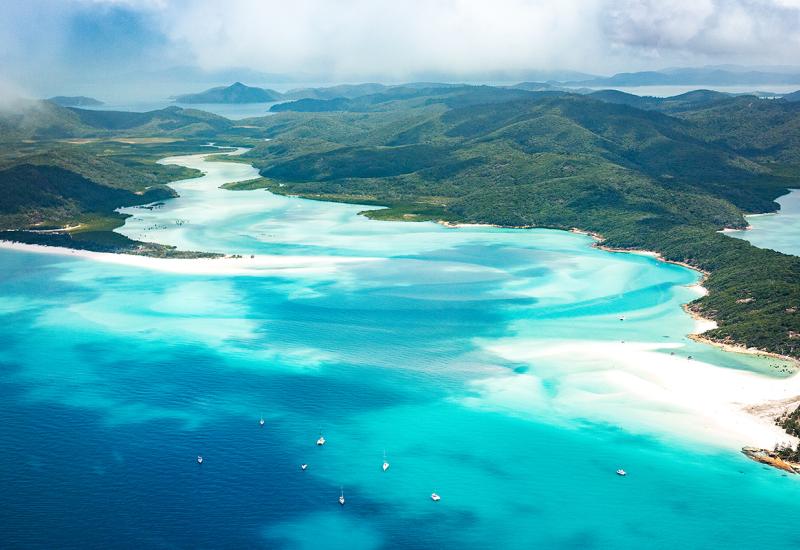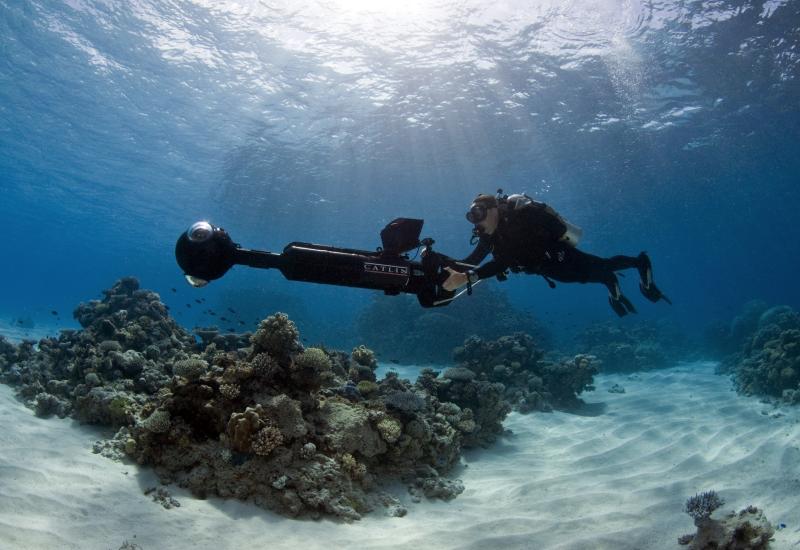50 Ways to Challenge Yourself as a Scuba Diver
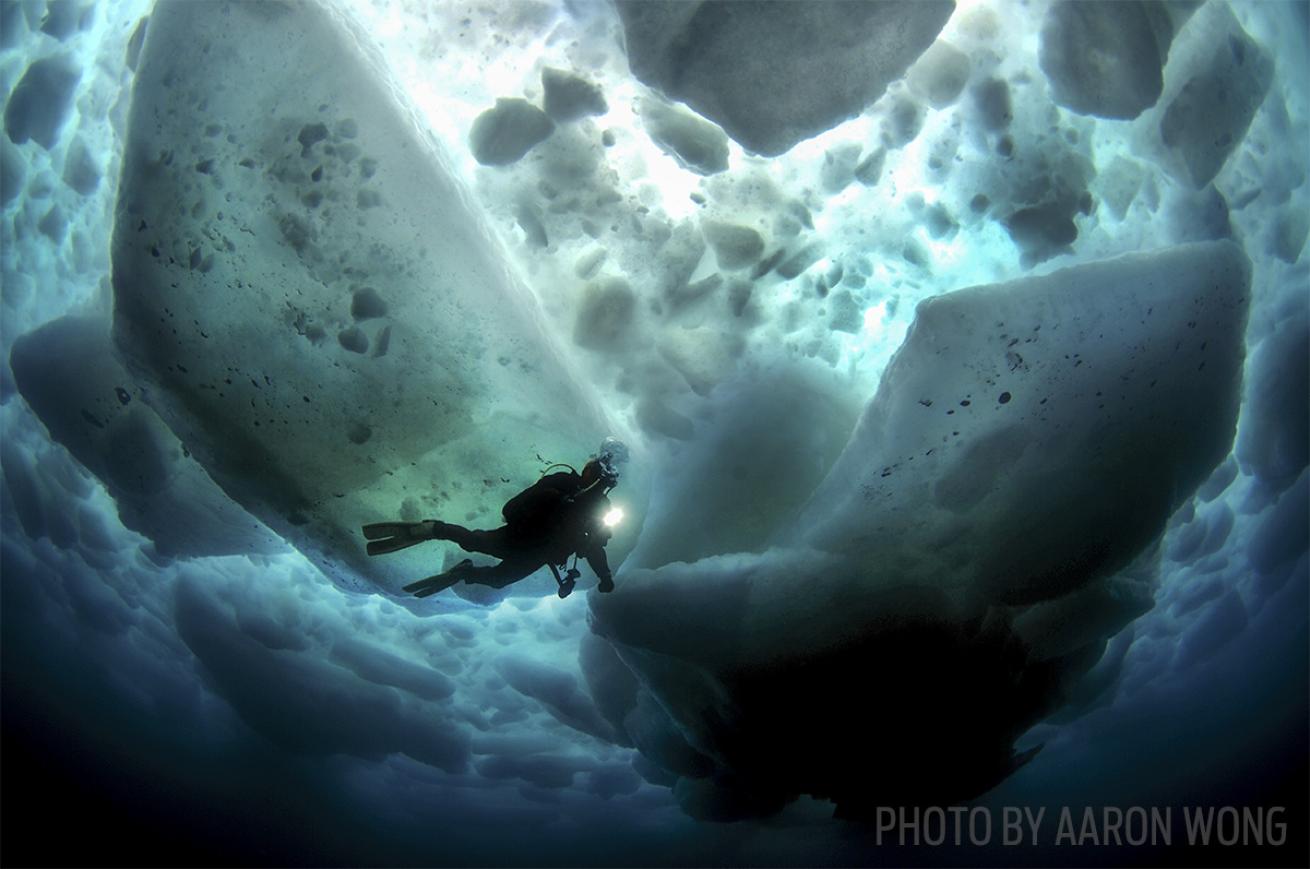
Aaron WongLearn a new skill set or try something new to up your scuba diving game.
We’ve all had that moment. Whether sitting around the liveaboard dinner table or in the resort pool, we hear another diver tell a story that sparks something … call it inspiration. Call it envy. Whatever it is, there’s no going back. Once this seed of a new adventure has been planted, we start connecting dots. Finding a good instructor for an advanced course. Looking for a buddy to share in an exotic expedition. Shopping for gear or airline tickets or both. Just as it should be. Because we didn’t come this far in our underwater journey to quit. The only way to go is forward. No matter how many dives you’ve logged or miles you’ve traveled, there’s always a way to improve your craft and fall in love with the sport all over again. We’ve chosen 50 wrecks, animal encounters, unique dives and training courses to reignite your passion.
1. Explore Caves
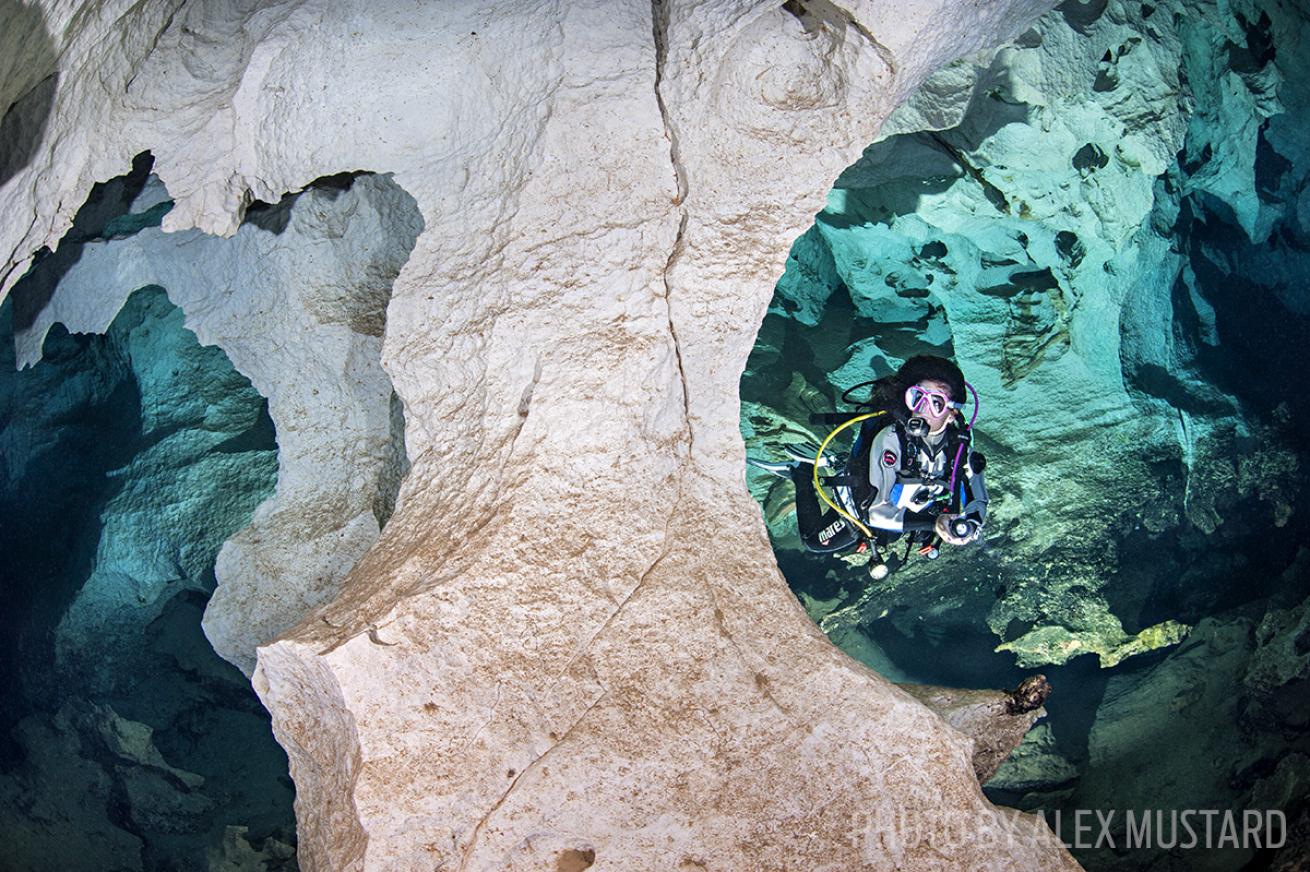
Alex MustardA diver explored Grotta Dei Fantasmi in Italy.
You Know You Are Ready When ...
Your curiosity about the unknown supersedes any fears of darkness or overhead environments. Mental prep is a must. Beyond mental preparedness, your buoyancy skills must be dialed in.
“Divers facing a cave for the first time have to deal with their relationship to the dark,” says Gaddo Risso, general manager of the Capo Galera Diving Center in Sardinia. That hurdle is made easier by the caves found on the Mediterranean island, including the 15-foot-deep Ghost Cave (pictured above), whose white limestone walls reflect the beam of dive lights, making the darkness more palatable for beginners. Another feature unique to the caves on this Mediterranean island is that most are tunnels — that is, instead of doubling back, divers enjoy a one-way route tracing a loop.
Or you can head to Mexico’s vast cenote network, which makes for an ideal classroom in that students can choose caverns and caves that slowly increase the distance from an exit point, thus gradually increasing comfort in overhead environments.
Another North American cave-training hub is Florida, namely the central and northwest regions. Caves here have flow — that is, a current that a diver typically has to kick against on the way in. Once a diver — who is appropriately certified — can skillfully handle himself in these conditions, he can easily dive caves anywhere in the world.
2. Archaeological Diving

Antonio BusielloDivers can go face to face with submerged statues off the coast of Italy.
Elsewhere in the world, you’d need to be at least an archaeology graduate student to witness underwater artifacts dating back to the first century. But the Archaeological Park of Baiae — one of the world’s only underwater archaeological parks — located less than an hour’s drive west of Naples, Italy, welcomes everyone with a C-card to explore this former haunt of Nero, Cicero and Caesar, who came to partake of the volcanic-fed medicinal hot springs. The site, discovered in 1959, still contains statues and the columns of the nymphaeum, a temple built to honor the water spirits.
3. Scoot Around
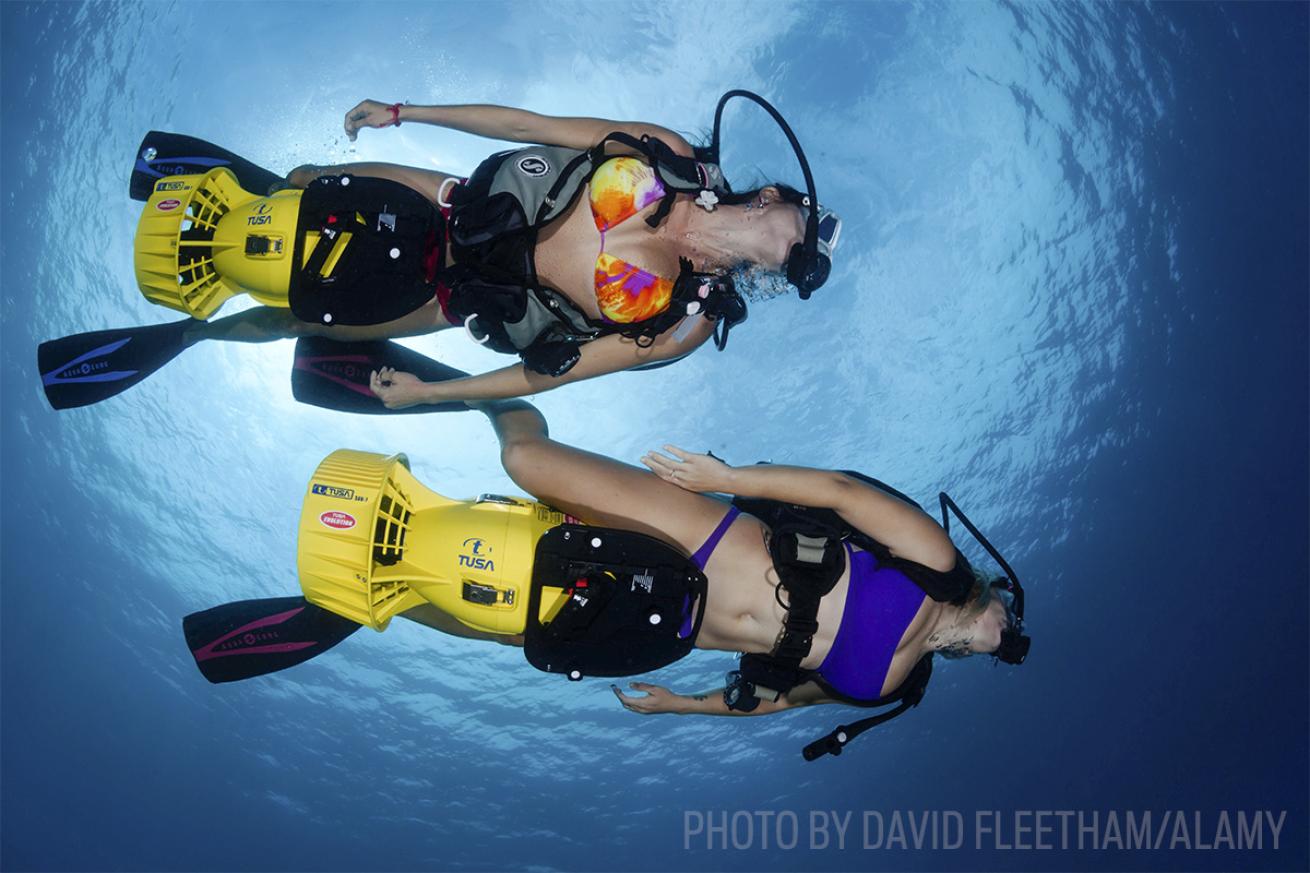
David Fleetham/AlamyDPVs can help you explore a dive site more efficiently.
Hands-free scootering might seem as tricky as unicycle riding, but rest assured, it’s not. “Anyone can pick up that style of diving within five minutes,” says photographer David Fleetham, who prefers the scooters because they keep his hands free to attend to his camera. Scooters can also make short work of long surface swims. Reaching shore-dive sites with long surface swims is much easier with a motor in the mix. “Ultimately, they’re like Jet Skis,” he says. “Because they’re noisy, everybody hates them, until they get on one — and then they love them.” jacksdivinglocker.com
4. California Shore Diving

Scott F McGee/Underpressurephoto.comDivers head to a dive site off the shore of California
The biggest challenge of California shore diving, according to locals, is parking. “You have to arrive really early to beat the beachgoers,” says San Diego-based underwater photographer Scott McGee. Which is one reason he favors winter for exploring sites such as La Jolla Shores (pictured above). The flip side of enjoying December’s unpeopled beaches is that the drysuit makes the eighth-mile walk to the shoreline more tiring. “By the time you get to the water, you could be out of breath,” says McGee. Collect yourself, then count the waves, timing your entry in between sets. You also need to be dressed for cool water, ready to don fins quickly and pop in your regulator pronto. Is the hassle worth it? You bet: The payoff is potential run-ins with sea lions, swarming jellyfish, bat rays, pipefish, nudibranchs and more.
5. Chuuk Lagoon Shipwrecks
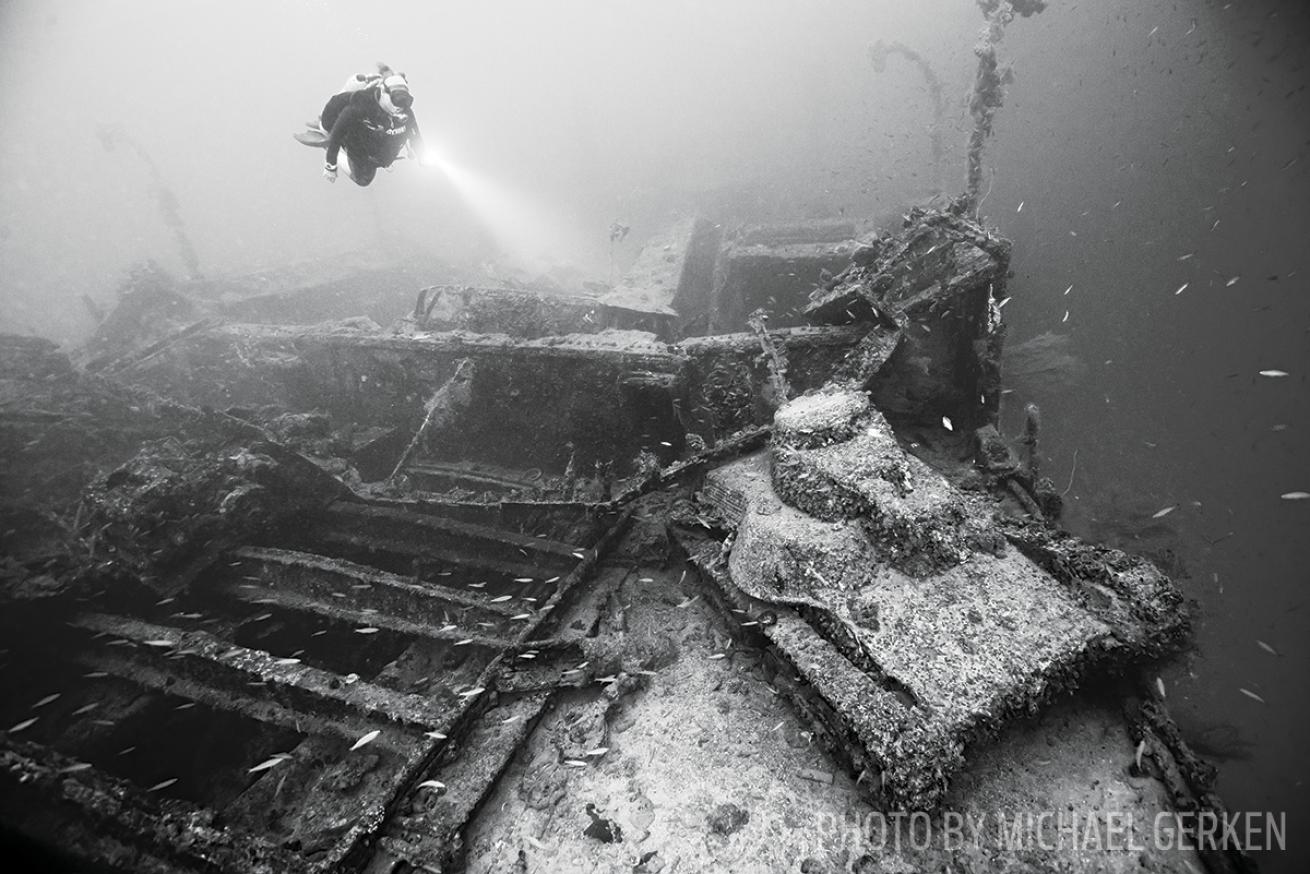
Michael GerkenThe San Francisco Maru
• Total number of divable wrecks: 32
• All of the ships are classified as Japanese war graves
“The average depth of the wrecks here in Chuuk is deeper than those of most other vacation destinations,” says Mike Gerken, captain of Truk Odyssey, which operates in this central Pacific lagoon. The wrecks of the World War II battle known as Operation Hailstone sit in water from 60 to 200 feet deep.
“The only challenges are depth and penetration,” he says. Current and viz are almost never an issue.
Penetration — both horizontal and vertical — is largely possible given how intact the ships remain, despite the majority having sunk on February 17, 1944. A wreck with penetration routes both challenging and simple happens to be Gerken’s favorite: the 500-foot Shinkoku Maru tanker. Entry through the smokestack leads to a tour of the engine and generator rooms, connected by still-intact catwalks.
Says Gerken, “It’s also one of most lush reefs ever, and the marine life is mind-blowing.”
The 450-foot Hoki Maru, starting in 79 feet of water, is another favorite, largely due to the cargo it sank with: Caterpillar tractors, stack-bed trucks, dump trucks, bulldozers, plus loads of ammunition. Perhaps the most popular wreck in the fleet is the 375-foot San Francisco Maru (pictured above), made challenging by its depth; the deck lies at 165 feet, where three Type -95 tanks remain. trukodyssey.com
6. Cage Diving with Sharks
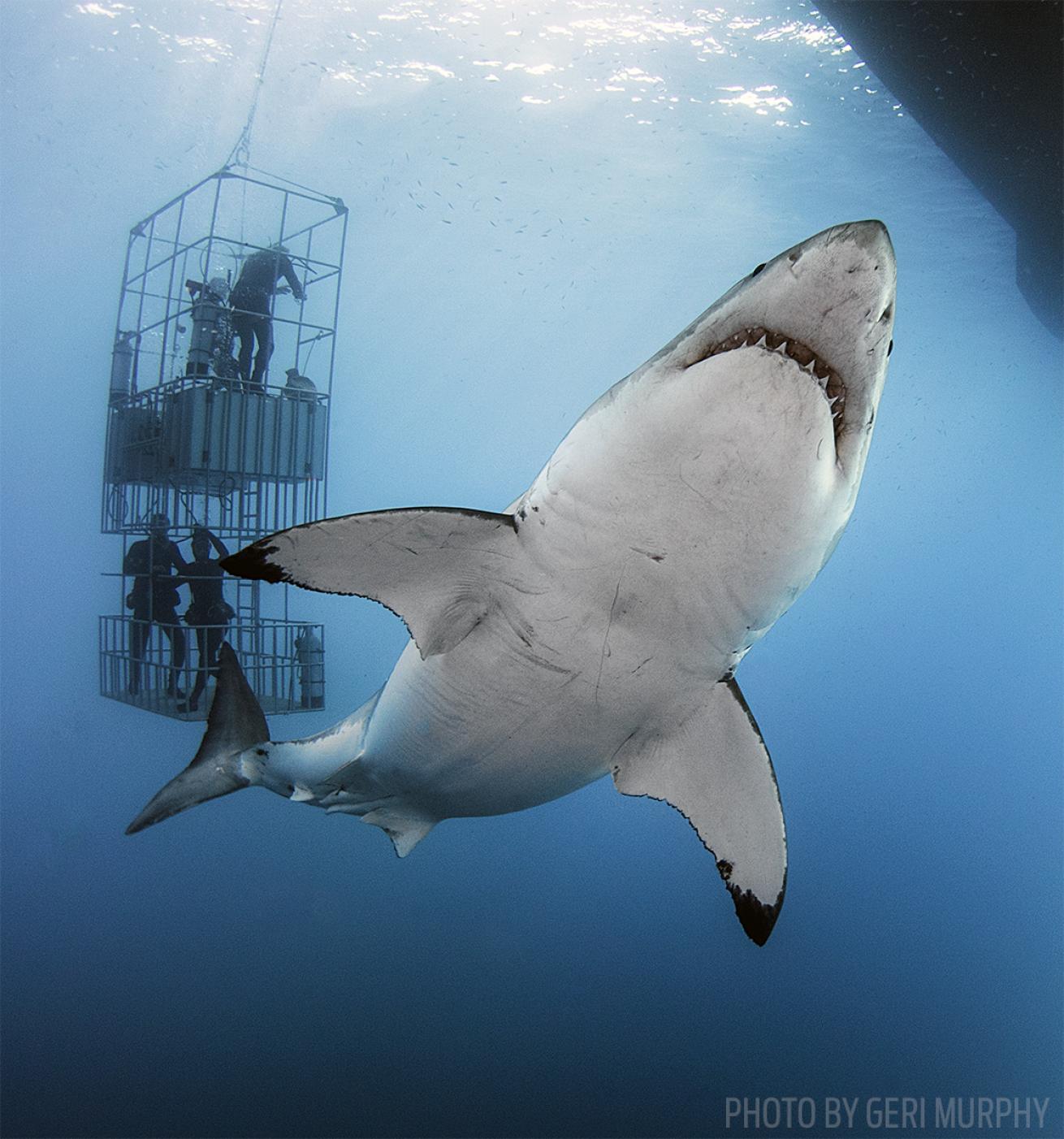
Geri MurphyShark diving off Guadalupe Island, Mexico
At first, it’s about the thrill of sharing the same patch of ocean with 15-foot predators. But as the adrenaline washes away and regular breathing resumes, divers realize they are watching a great white shark soap opera.
“The newest thinking is that Guadalupe is all about sex — not predation, which is what we had figured,” says Mike Lever, founder of the Nautilus Explorer fleet operating in the shark haven 150 miles west of Mexico’s Baja Peninsula.
This theory explains why fewer females, the larger of the two sexes, appear annually. The 18-month gestation period keeps them occupied at inshore nurseries, where it’s believed females deliver pups in May and June, not arriving in Guadalupe until September.
And before the ladies appear, the males are consumed with establishing dominance. Like teenage boys, they roughhouse to determine the pecking order.
“Males approach, parallel to one another, until the smaller one peels off,” says Lever. The story line is ever present, ever evolving — but to the uninitiated, it can seem like a telenovela to a non-Spanish speaker. Once the guides share the back story, the action becomes a thousand times more addictive. nautilusexplorer.com
7. Citizen Science
The possibilities are as varied as the terrain we dive. Photos of never-before-seen frogfish can persuade marine biologists that an unnamed species exists. Divers can help with fish counts, organized through REEF. Or help track reef health through Reef Check. Those who photograph whale sharks and mantas can identify individuals to help organizations such as Wildbook for Whale Sharks or Manta Matcher track migration routes. Just about anything you imagine helps, does.
8. Dive from a Helicopter
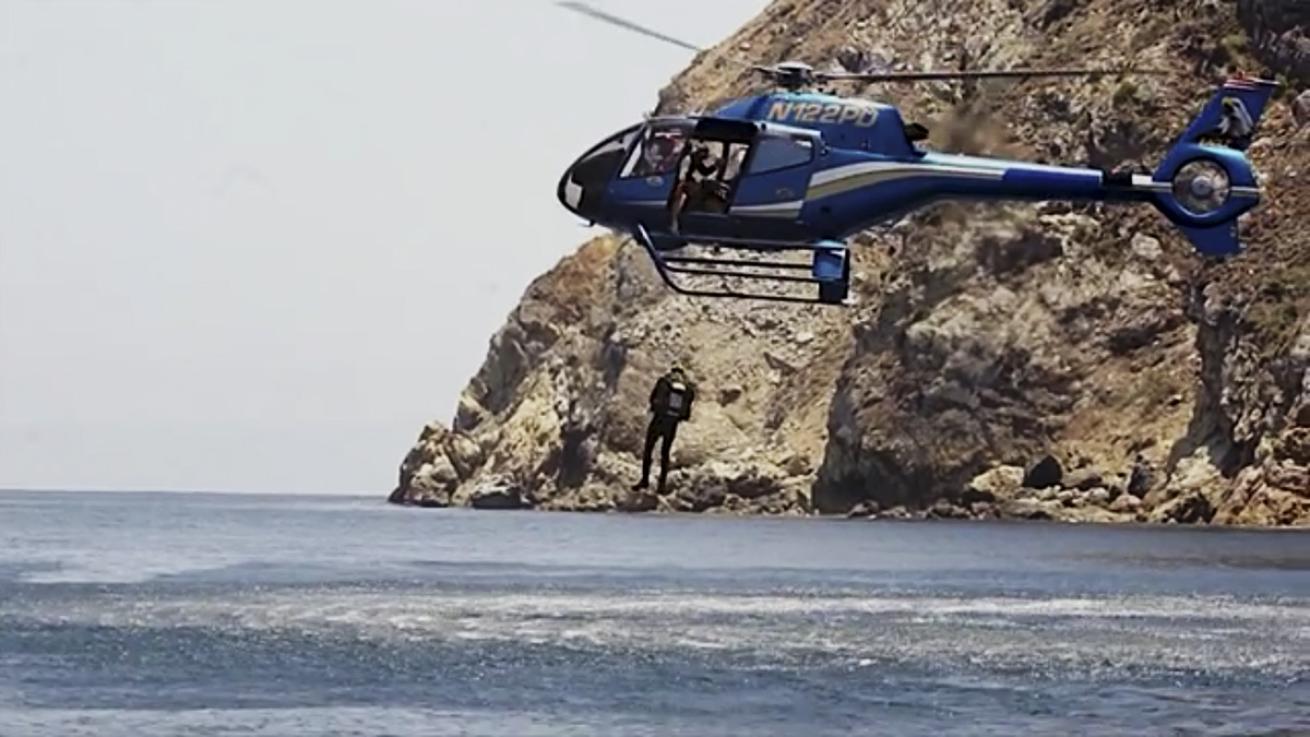
Henry GorenA diver takes a truly giant stride from a helicopter
The helicopter door opens and it begins. Wind rushes in and perception narrows. Temporary deafness ensues. Divers sit ready, but in a position different from most giant strides: They must carry, not wear, their mask and fins. The dive site sits 20 feet below. Yes, heli-diving is a thing. And at OC Helicopters in Los Angeles, you can take a PADI Heli-Dive Course and experience the thrill for yourself.
9. Book a Liveaboard
Liveaboard diving, with five dips a day pretty much standard, is the best way to bump up your skills a level in just one vacation. Sure, you might lose the beach day that comes with a resort getaway, but that’s the point. You will get tired with all that diving. Nitrox helps offset the fatigue. Your best bet, says photographer David Fleetham: “Don’t skip the snacks. And as for sleep, catch up when you’re back home.”
10. Freediving
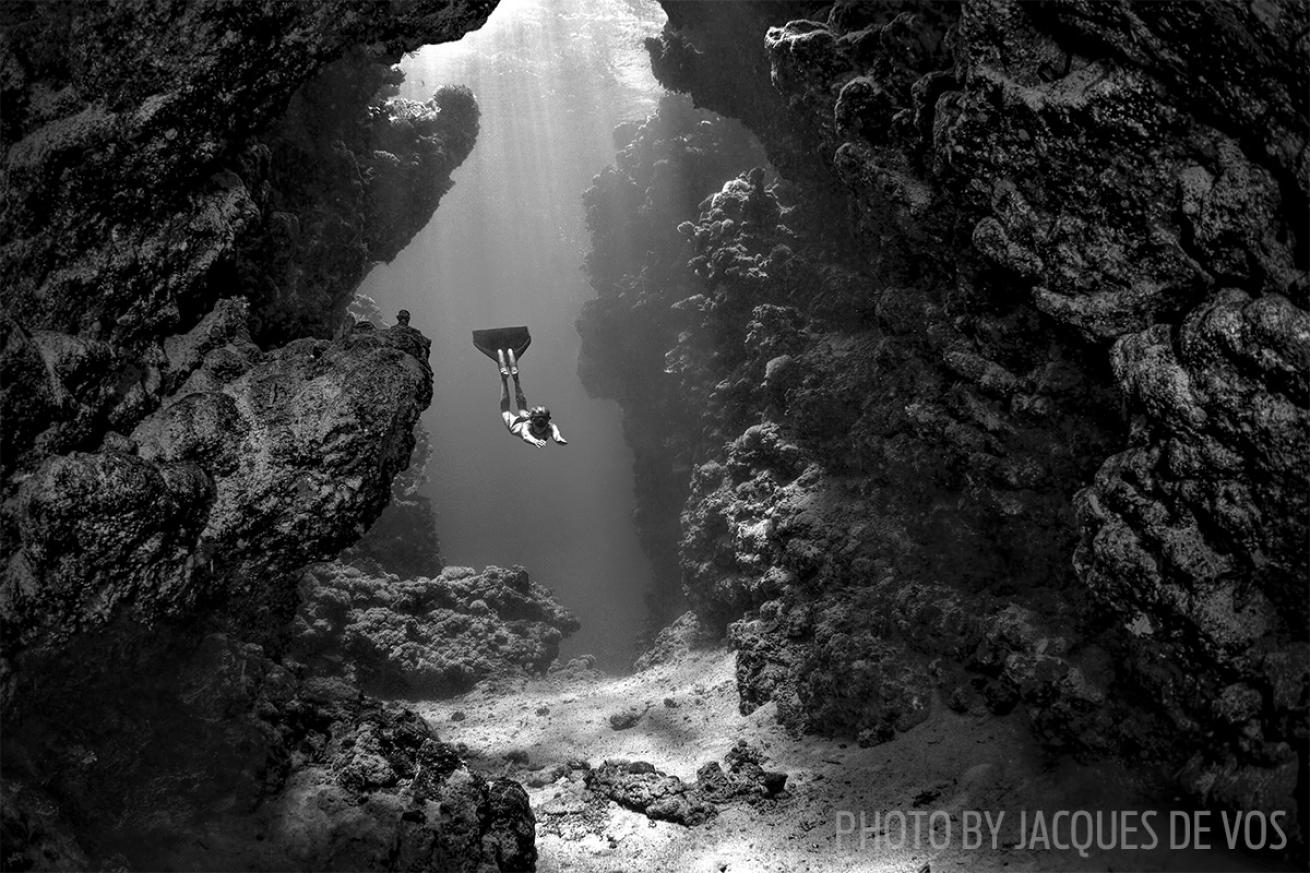
Jacques de VosA freediver explores the waters off Ras Mohammed National Park
Freedivers often describe a high that most tank toters haven’t experienced.
Medal-winning competitive freediver Estella Navarro describes the free fall as a captivating experience: “The water inside the body and outside become one, and the skin just vanishes.”
The drop creates a uniquely relaxed mental state — as one might expect given that the heart rate drops dramatically. One must remain cool, calm and collected when regularly swimming to depths between 100 and 200 feet. Panic is not an option.
And so practice becomes much more necessary.
The preferred training destinations offer deepwater access just feet from shore. The short list of such places includes Dean’s Blue Hole on Long Island in the Bahamas. Or Ras Mohammed National Park, Egypt (pictured above), where sheer drop-offs are yards from shore. There, freedivers can drive to a preferred put-in. Sites aren’t marked, named or numbered because few folks partake of the area’s shore diving — which means solitude can be had easily for freediving partners.
11. Dive in Open Ocean with Sharks
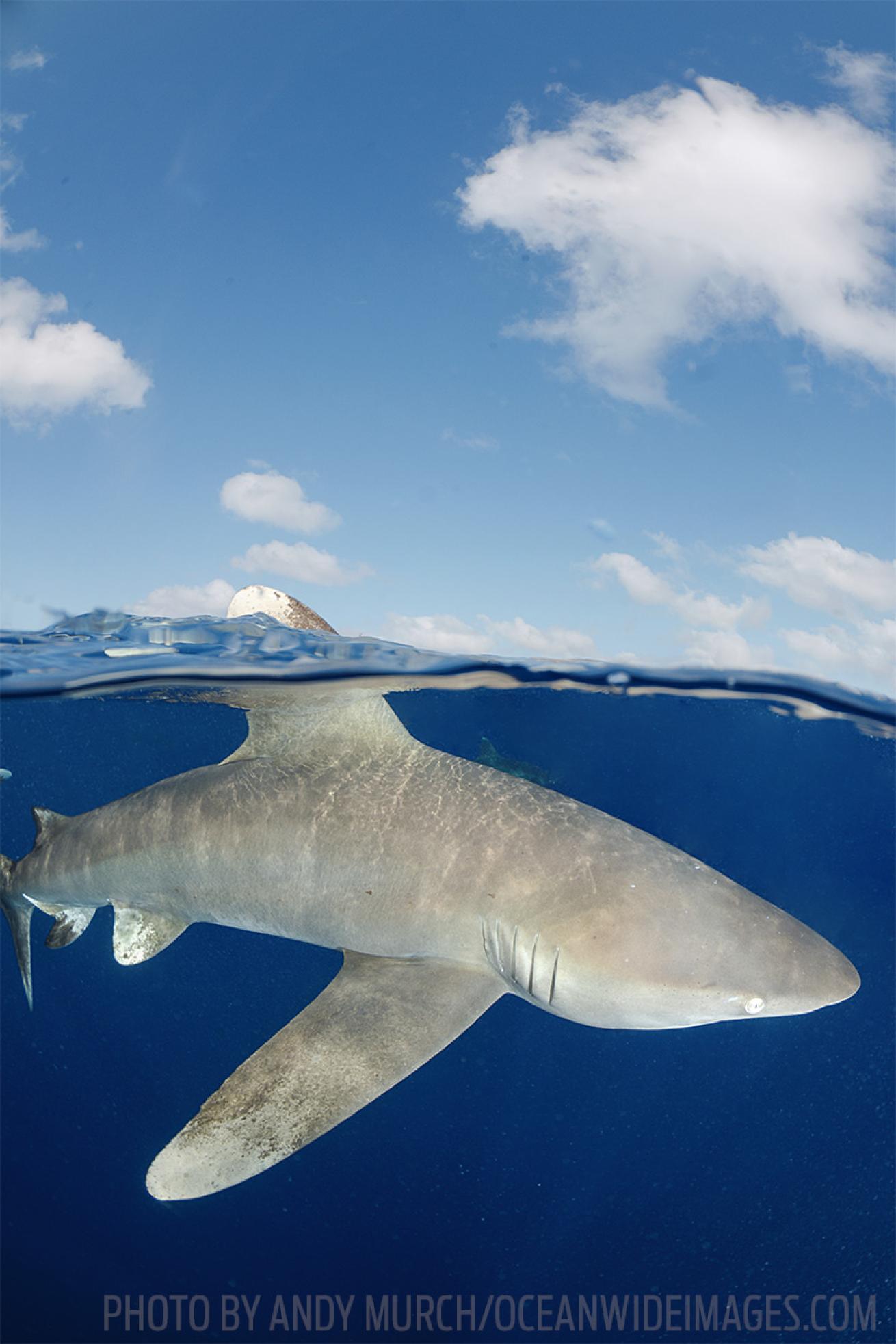
Andy Murch/OceanwideImages.comAn Oceanic Whitetip Shark shown off Cat Island, Bahamas
“You have sharks coming at you from all directions, 360 degrees of sharks — above you, below you and on each side,” says Andy Murch, trip leader and founder of Big Fish Expeditions.
Divers might think a shark dive is a shark dive, but the experience with oceanic whitetips deviates from the expected. The typical shark dive involves divers kneeling on sand — or in some cases, looking out from inside a cage — whereas this bluewater encounter can invoke vertigo as divers’ heads spin to track incoming guests.
The dive can be taxing to those unaccustomed to open-ocean diving; but the greater challenge befalls the whitetips.
Says Murch: “A recent study found that this species may have been reduced to 2 percent of its former numbers. So to have the opportunity to dive with them off Cat Island (Bahamas) in still-abundant numbers is quite a special thing all on its own.”
Go a Little Deeper
12. If you Like to Dive Sergeant Major ... Try First Cathedral, Lanai, Hawaii
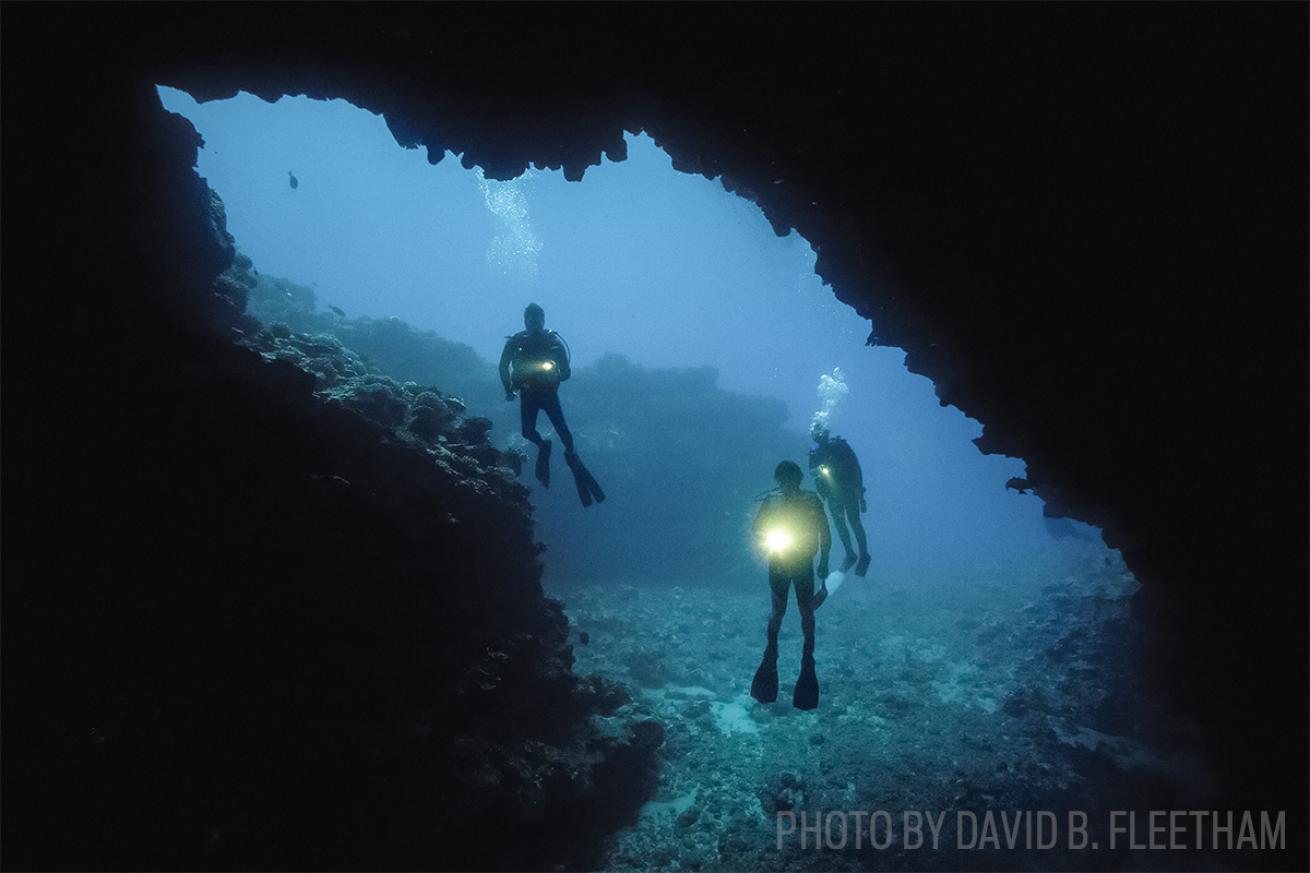
David B. Fleetham/Seapics.comDivers explore First Cathedral off Lanai, Hawaii
Like Sergeant Major, First Cathedral has a large archway. The deeper of the two dives at 70 feet, First Cathedral is a more complex warren of caverns, pinnacles and rooms — and with more nooks come more marine life, from whitetip reef sharks to green turtles, seeking sanctuary.
13. If You Like to Dive Coral Gardens ... Try Fairyland, St. Lucia
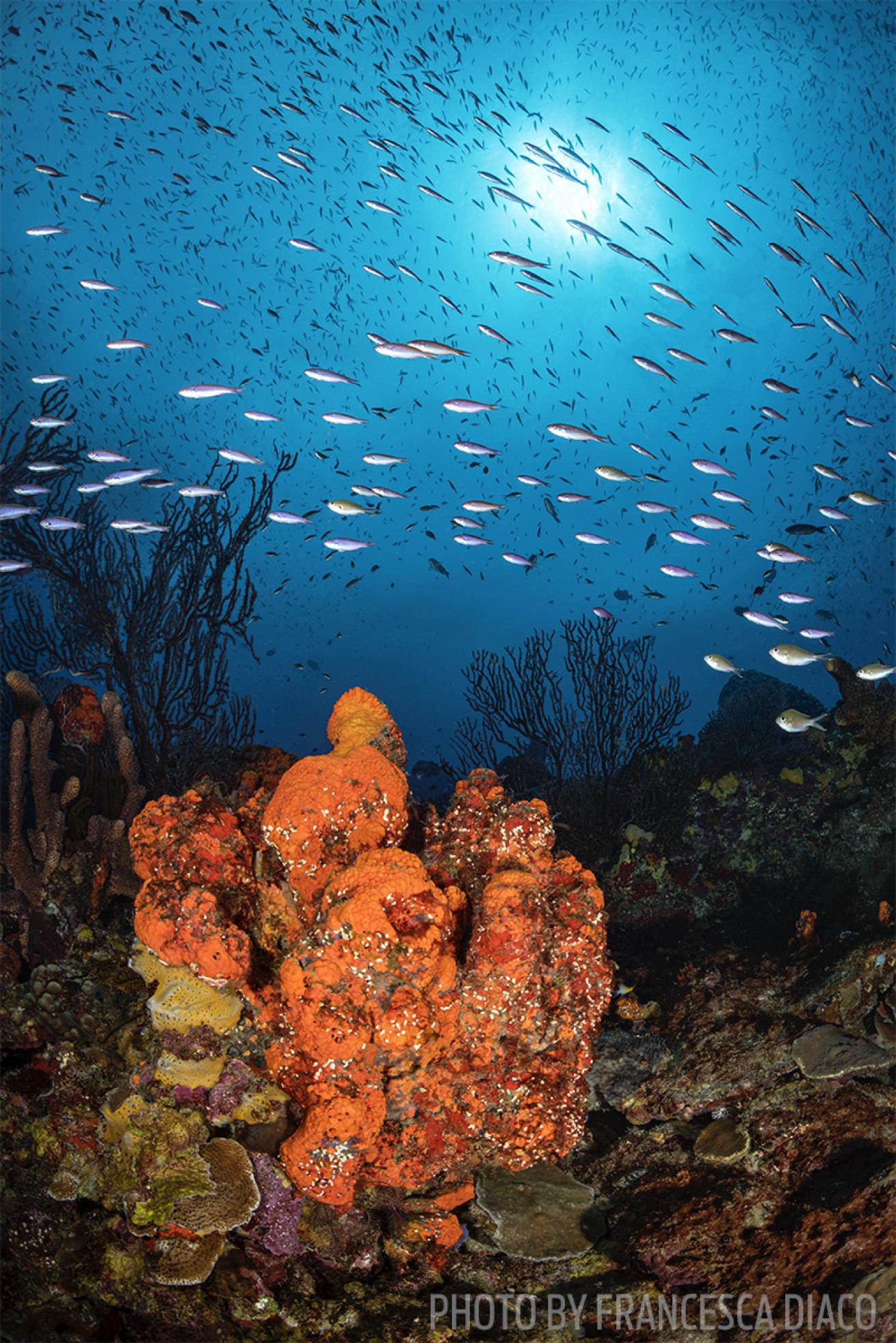
Francesca DiacoThe dive site Fairyland in St. Lucia
Sure, the name is cutesy, but this St. Lucia dive site is as pleasurable as Caribbean diving gets. A current makes Fairyland a drift dive above tiny forests of coral, giving visitors the sensation of what it’s like to have wings, taking flight above reefs as well as the edge of a wall.
14. If You Like to Dive Aquarium ... Try Long Caye Wall, Belize

Brandon ColeThe dive site Long Caye Wall in Belize
This Belize site packs the same amount of schooling fish as Aquarium, but with the dramatic topography of a sheer wall falling to 2,600 feet. You’ll also get more underwater diversity with white-sand patches home to garden eel colonies, plus beds of elkhorn and black corals.
15. If You Like to Dive Richelieu Rock ... Try Hin Muang, Thailand

Scott JohnsonA radiant coral grouper at Hin Muang
Thailand’s deepest wall dive, Hin Muang — an offshore pinnacle like Richelieu Rock — is covered in macro life that thrives among forests of purple soft corals and anemones. The site is also a plankton-collecting oasis, attracting legions of mantas, as well as the occasional whale shark.
16. Help Coral Restoration

Tanya G. BurnettA Coral Restoration Foundation volunteer diver works on a coral nursery off the coast of Florida
First, divers practice with Play-Doh. The child’s toy has the same texture and give as the all-natural marine epoxy that the Coral Restoration Foundation — an organization in Key Largo, Florida, that is dedicated to regrowing reefs — relies on to anchor coral branches to new homes. In the water, divers must first clean the reef of algae, then affix the corals. It’s the chance to observe firsthand how quickly corals grow, plus understand the most harmful stressors and the challenges each coral species faces. The CRF has six nurseries off Key Largo — the largest is 1.5 acres with 300 coral trees — and it welcomes divers to come for one- and two-day programs. Internationally, the program is offered in Bonaire at Buddy Dive Resort and in Curaçao at Ocean Encounters.
17. Discover Florida Keys Shipwrecks

Tanya G. BurnettA diver explores the Spiegel Grove
• Wrecks in the Keys’ Wreck Trek: 12
• Total feet of divable metal in the Keys: 3,318
What Florida’s wrecks lack in history, they make up for in size. The Florida Keys pack the largest metal concentration, made easier to enjoy thanks to warm water and reliable conditions.
The 510-foot USS Spiegel Grove landing ship off Key Largo is a hallmark dive — primarily because there’s an overwhelming amount to see: gun turrets, helicopter pads, the bridge and more.
“The Spiegel looks like an underwater hotel,” says Dan Dawson, owner of Horizon Divers.
USCGC Duane also makes our Keys’ top three. There’s always current. The challenge is staying on the structure, but the rewards are many. Says Dawson: “There are tons of swim-throughs because the ship is relatively narrow. You’ll go in and out of rooms that are covered in orange cup coral.”
Key West has been home to the biggest of the Keys’ artificial reefs since 2009, when the 522-foot USNS General Hoyt S. Vandenberg was shown its final resting place underwater. The radar dishes, cargo-hold shafts and 11 elevator shafts make for a kid-in-a-candy-store penetration experience. oceandivers.com; rainbowreef.us; seadwellers.com
18. Meet Crocodiles
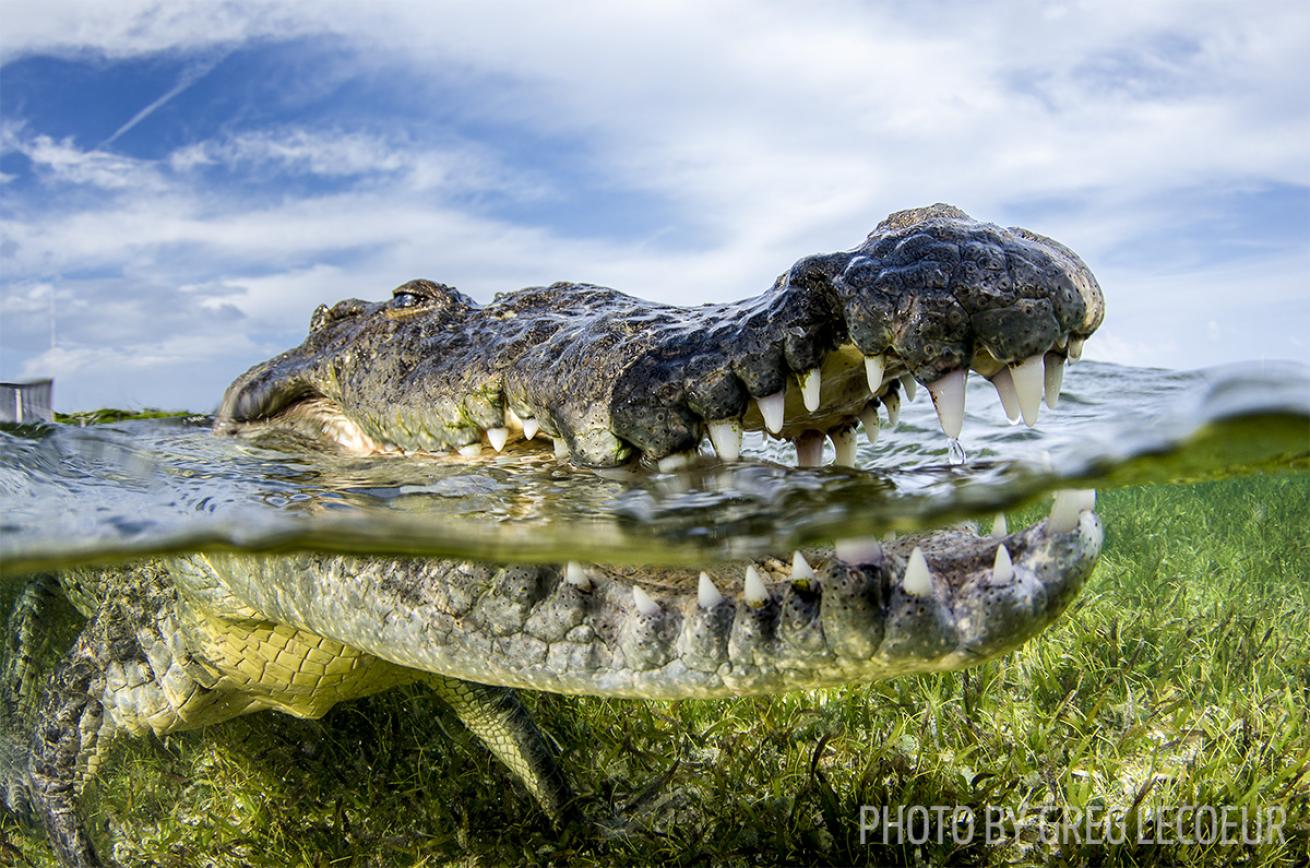
Greg LecoeurA crocodile gets in close to the camera off Mexico's Chinchorro Banks
You Know You Are Ready When ...
You can defend your space by communicating with your body. Speaking in a language apex predators understand means staying big, holding your ground and moving toward them, not away, when they near.
“Crocodiles are very different from sharks because they are reptiles, which are very unpredictable,” says Greg Lecoeur, who met the animal when diving Mexico’s Chinchorro Banks, an atoll reef 36 miles from the pier of Xcalak.
“Sometimes nothing happens — sometimes they just sleep,” he says, which is what happened on his first dive. But he knew he’d have several more chances — the trip out to Chinchorro is so long, it warrants an overnight at fishermen’s huts perched on stilts.
On his second dive, he experienced what he came for, starting with the animal creeping toward the surface. “It looks very scary, but they are just breathing,” he says. Then the animal approached Lecoeur.
“I used my camera to nudge him, to deflect his advances,” says Lecoeur. “You have to stand your ground.” Which can be mentally taxing because the American crocodile can span up to 20 feet. Plus, they often display much more curiosity than sharks. Should a diver turn his back on a croc, that opportunistic hunter will likely sneak in for a closer look. Adds Lecoeur: “Every minute with the animal is amazing. It’s like diving with dinosaurs.” xtcdivecenter.com
19. Experience the Galapagos

Greg LecoeurAn eagle ray off the Galapagos Islands
One of the world’s most challenging dive spots is, in a way, also one of the easiest.
The converging currents that make the Galapagos Islands so species rich are also responsible for ramming divers right off the reef — and into blue water and beyond. Losing the frame of reference that is the reef is a no-no.
Many guides suggest descending, finding a patch of rock or dead coral, and getting comfy. Newbies make the mistake of chasing wildlife. But the old hats know: The more still you are, the sooner the schools of hammerheads or eagle rays appear like magic. aggressor.com
20. Sharpen Your Navigation Skills
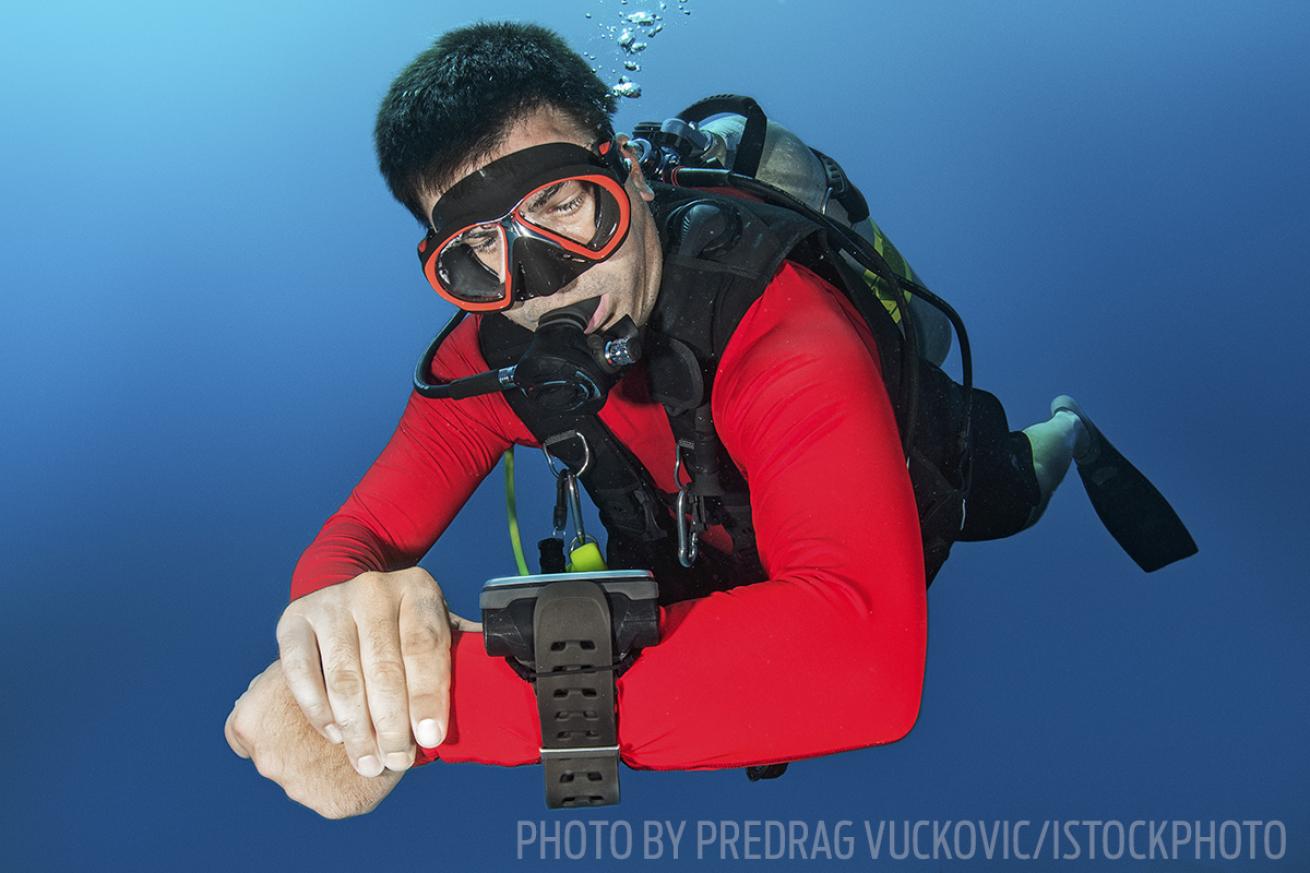
iStockphotoNavigation skills are crucial for safe diving
We’ve all heard the joke about the diver using fish as navigational aids, but just because we chuckle doesn’t mean our own skills are perfect.
If it’s been a while since you’ve spun a compass bezel, consider taking a refresher course.
“So often you think you finally found that unique feature to use as a marker, but when you head back, suddenly you see that feature — be it a tire or a brain coral — everywhere,” says Bart Linders, instructor at Buddy Dive Resort Bonaire. “Look for a combination of things, like a giant brain coral with two tube sponges on one side and the barrel sponge on the other.”
21. Make the Plunge: Cold-Water Diving
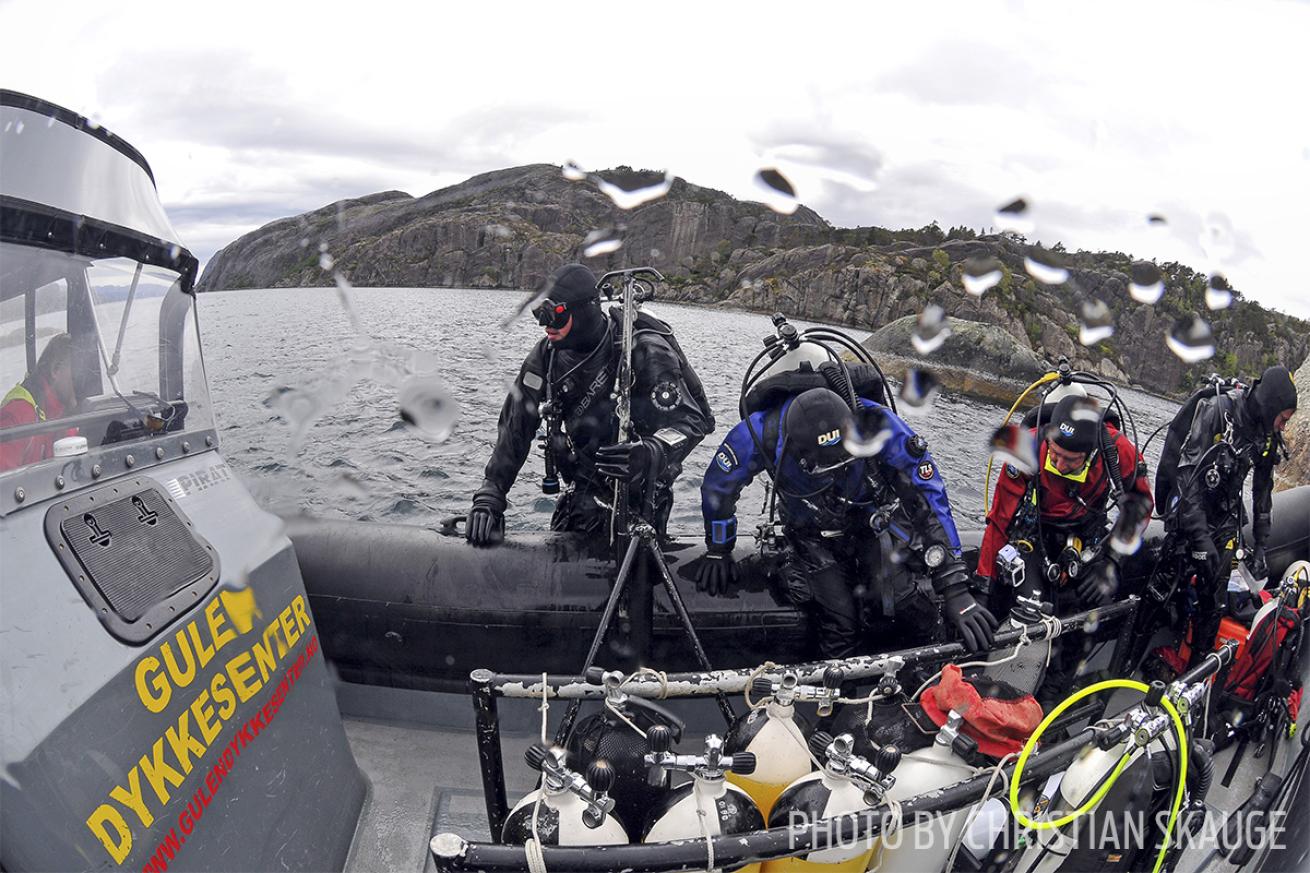
Christian SkaugeDivers settle in after a cold-water plunge
“You have to be able to operate everything basically blindfolded,” Christian Skauge, editor of the Norwegian magazine Dykking, says of cold-water diving.
He’s referring to the extremely limited mobility afforded any diver bundled in a drysuit and hood. The drysuit’s thick neck gasket — combined with a hood — makes it nearly impossible to turn and see your body.
Then consider what happens when a diver’s bladder is full. Bodies expend energy warming that liquid. But gear and bladder concerns aside, half the world’s diving opportunities — and many more amazing species, wrecks and natural features — lie in cold water. And the wrecks of Norway’s Krakhellesund Sound (an experience that the divers pictured above just finished) lie in a well-sheltered area, which has protected them for more than 70 years.
22. Hunt Lionfish
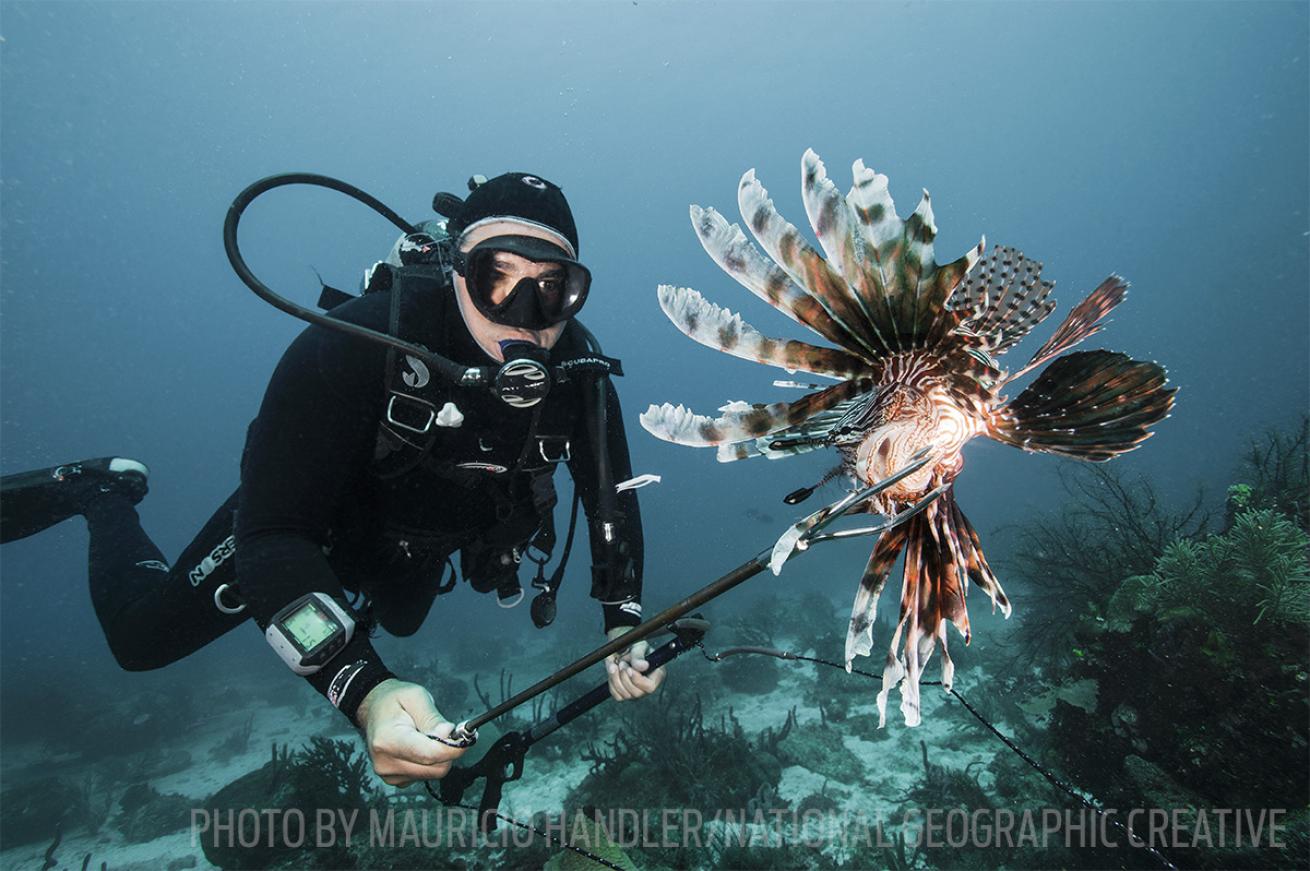
Mauricio Handler/National Geographic CreativeA diver hunts for lionfish off the Dominican Republic
Snagging these non-endemic reef razers in the Caribbean and western Atlantic becomes easier with the right gear. Start with a spear that has barbs on the ends of the tips to ensure your dinner doesn’t wiggle free.
“Without the barbs, lionfish can come off the spear, and then they’re pretty mad,” says Dan Dawson, instructor at Horizon Divers in Key Largo, Florida. Also consider a bag with a oneway lid, such as the Zookeeper brand, to keep the fish from darting out.
23. Visit the Titan Missile Silo

Mark TheuneDivers explore the Titan Missile Silo
First you gear up and climb down a ladder. Then you’re in a decommissioned nuclear missile site outside Royal City, Washington. Wade through waist-deep water of the tunnels leading to the launch tube — which flooded naturally.
Though safe, the site, with its high-voltage warning signs, was never fully cleaned for divers. That would remove the history, including the steel cribwork that held a Titan I missile and remains now at the end of a glorious free fall.
24. Dive Under the Ice
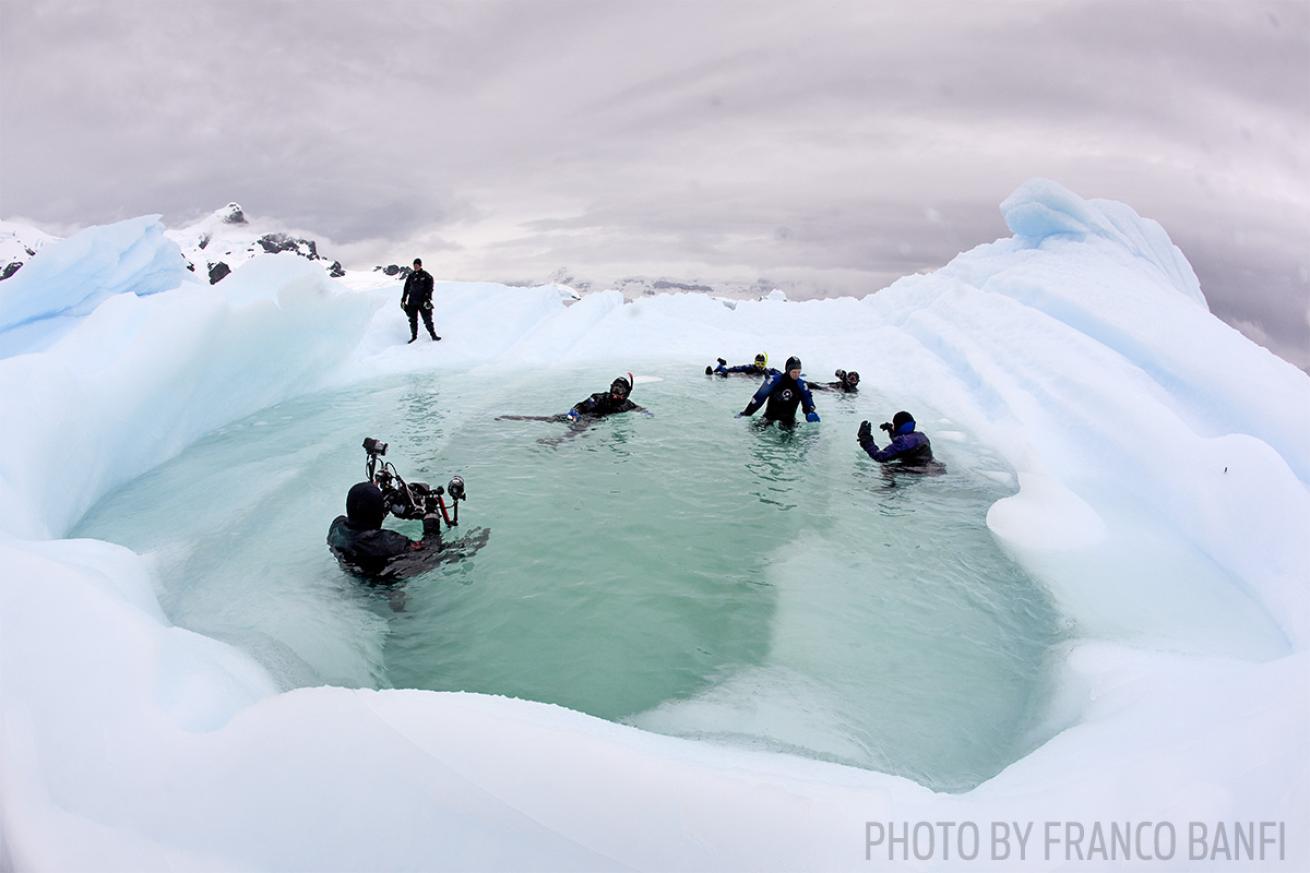
Franco BanfiDivers enjoy a water pool, formed on a iceberg floating in the Antarctic peninsula.
Unpredictability is the greatest danger of marine ice diving — that is, swimming alongside icebergs and floe edges of places such as Antarctica.
The easiest rule is to think of ice as alive. Each is always shifting, rolling and breaking apart. Moreover, icebergs are so large that they appear to be fixed points, but that’s an illusion, much like standing on a train as the one on the next track departs. So it is with bergs. Keep your eyes glued to one, and only your ears alert you to the fact that you’re moving. The urge to equalize will be your first clue.
And active listening helps. But don’t forget to take a moment to appreciate the residents you might meet in this frigid locale: starfish, soft corals, jellyfish, sea squirts and more.
25. Go Professional
“Being a PADI dive instructor is your passport to the world,” says instructor Liz Parkinson. Before working at Stuart Cove’s Dive Bahamas, a PADI Five Star Instructor Development Center, she earned pay underwater in Hawaii, the Red Sea, Turks and Caicos, and the Cayman Islands. But even if you stay and work at one location for the duration of your dive career, you’ll meet people from all around the world because nearly every dive center is a veritable U.N.
26. Go Solo
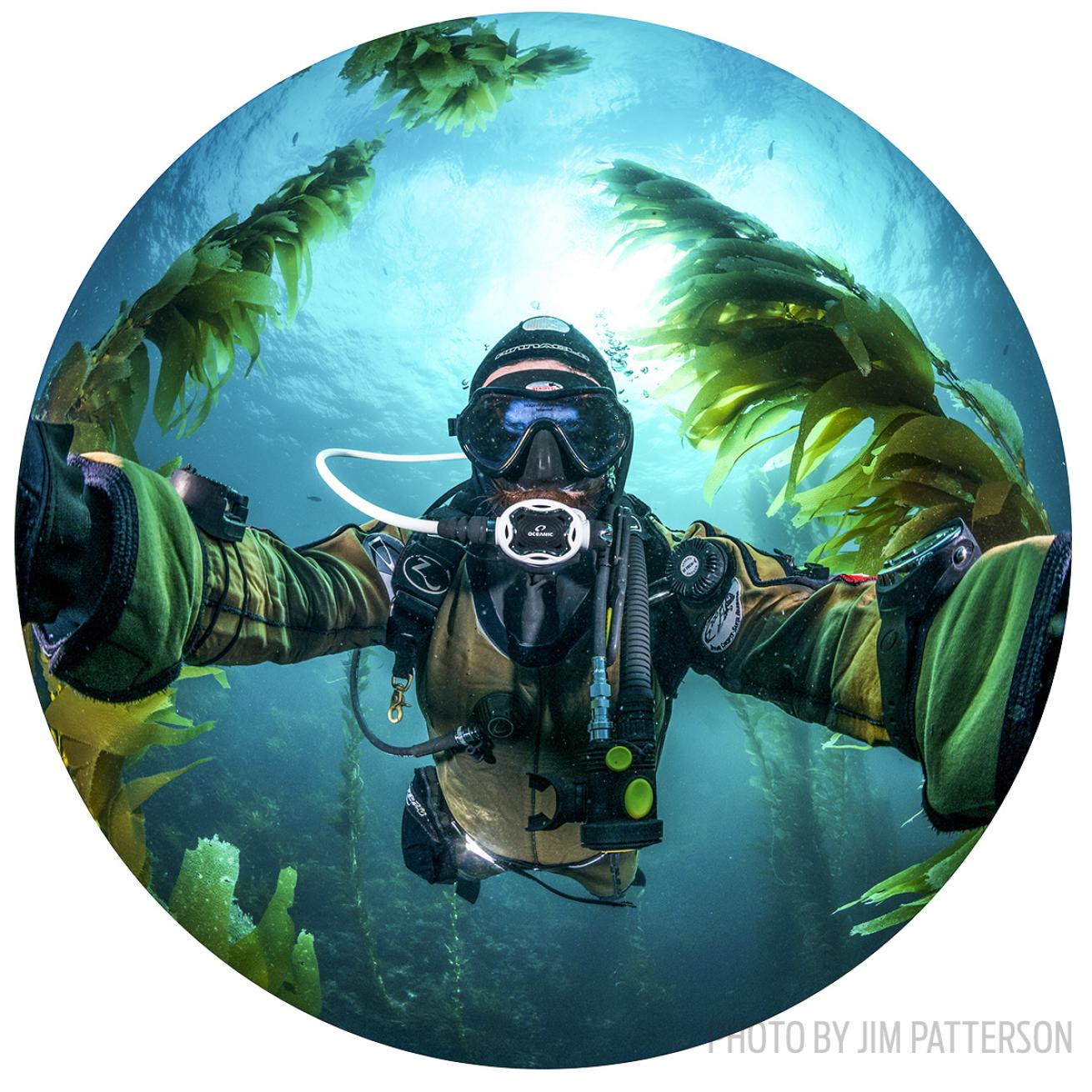
Jim PattersonA diver takes a selfie off San Clemente Island, California
Solo diving isn’t what happens when you don’t have friends, but when you pursue a certification that prepares you to dive alone. The skills include learning to switch to a spare tank and handling problems like a broken fin strap or lost mask. Ultimately, it’s about talking yourself off the ledge of panic when you’re disoriented. Because when there’s no buddy to help, you become self-reliant — which ends up making you a better buddy.
27. Go Sidemount
For cave divers, this style — with two cylinders positioned on their sides — is especially popular because it allows them to negotiate through tight spaces. Says Don Labbruzzo, instructor with Deep Exposure Dive Center in Cozumel, “If you can get head and shoulders through, you can go through — whereas with doubles, you cannot.” Plus, carrying two single 80s is easier than lugging doubles.
28. Brave the Sardine Run
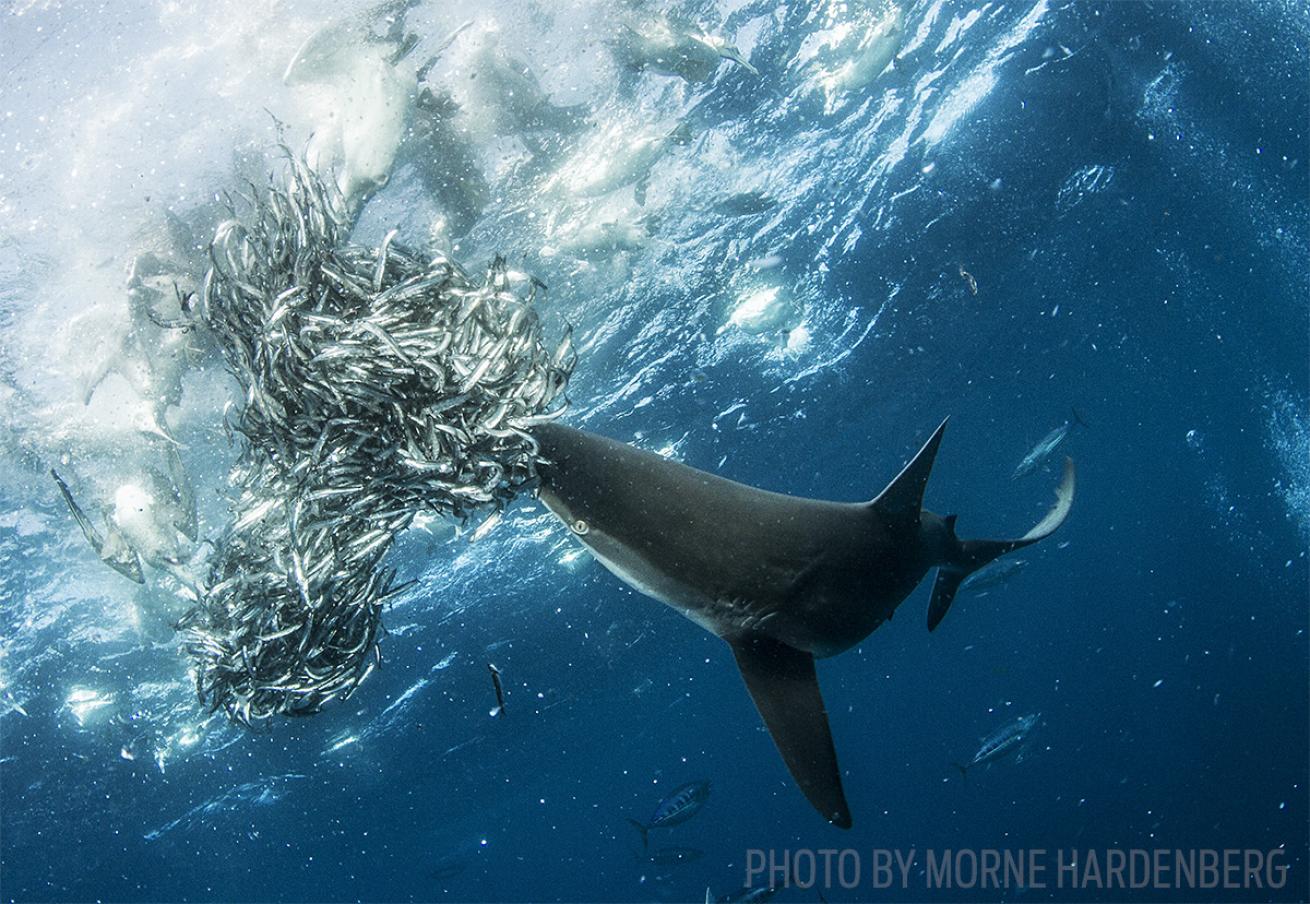
Morne HardenbergA shark feasts during the Sardine Run
Thrill- and photo-seeking divers flock to the southeast coast of Africa every May through July for a big-animal parade like no other.
Along with a shark lineup that includes the great white, tiger, bronze whaler and Zambezi (aka bull shark), there are also dolphins and whales with tickets to the same buffet of billions of migrating sardines. “Bryde’s whales come blasting into those baitballs at full speed, with their mouths open, not seeming to care about divers,” says photographer Doug Perrine.
But all the action is contingent on a lot of circumstances lining up, including having a boat power past the tides to reach the baitballs. And most often, dive guides are relying on spotter planes to find these baitballs, each of which could satiate a feeding frenzy for roughly 15 to 30 minutes, depending on size.
You could end up just getting sunburned on a boat, but the best days are truly epic.
Says Morne Hardenberg, “This baitball was the size of a small truck until it was pushed to the surface by a few hundred sharks.” And that show continued until the last sardine was spoken for, 70 minutes later.
29. Mug with Leopard Seals
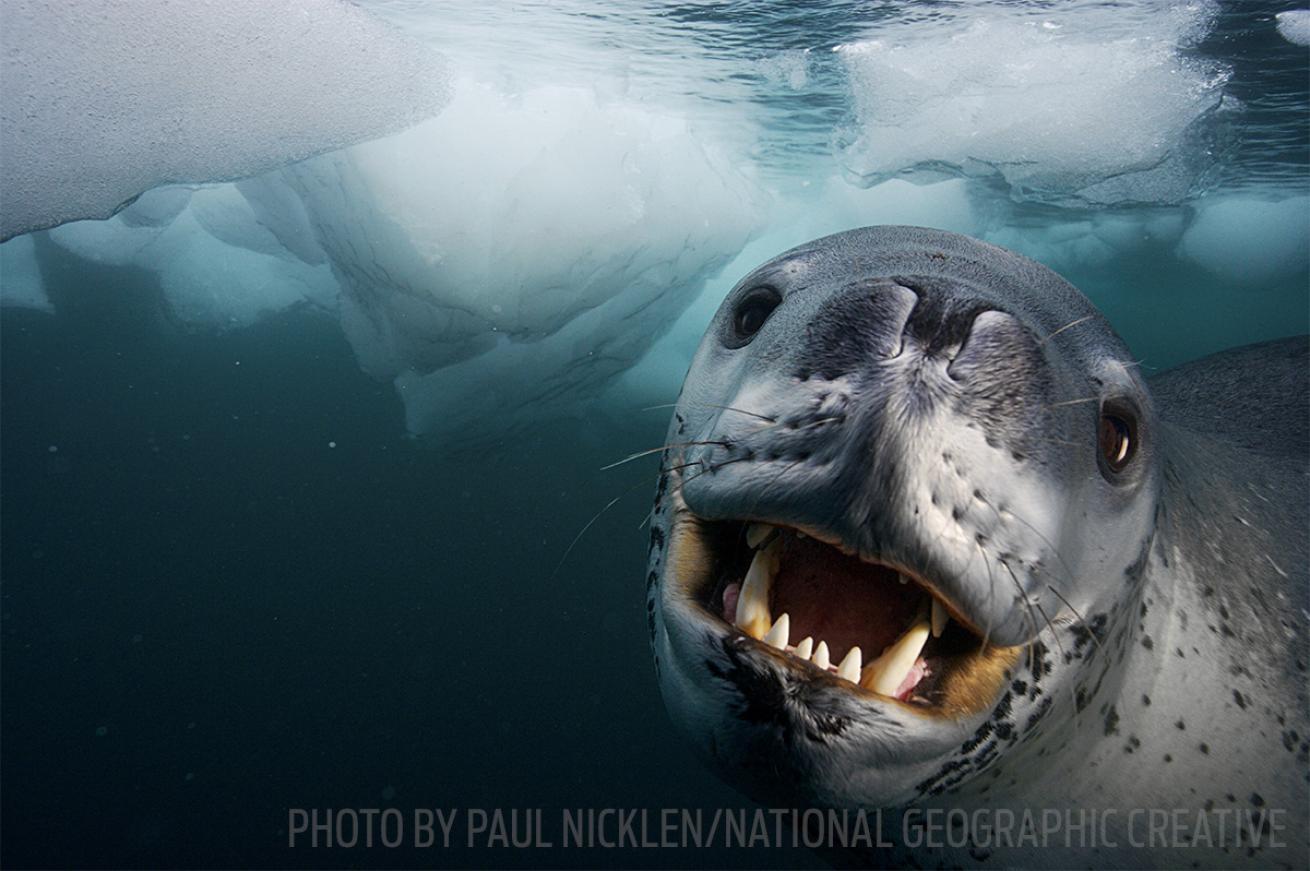
Paul Nicklen/National Geographic CreativeA leopard seal off the Antarctic Peninsula
“The second I jumped in, this huge animal was 5 inches from my mask,” says Goran Ehlmé, a Waterproof Expeditions trip leader, of his first time snorkeling with leopard seals off Antarctica’s Dream Island.
“That was when I realized I wasn’t prepared,” says Ehlmé. “I went flying out of the water like a rocket, scrambling back into the Zodiac.” Then the seal began biting the boat. “Leopard seals don’t look cute like other seals — they look a little evil,” he says.
His second attempt to swim with the penguin-eater deviated little from what was quickly becoming a pattern. Ehlmé was determined to figure out how to dive with these animals because he promised his boss he would. Again he jumped into the water.
“This time it came at me with a closed mouth,” he says. “It rolled its head back to look at me.” Ehlmé jumped toward it, and it retreated a bit. “In that moment, I understood that it was just playing. Now, it has been many years since this day. I have been in the water with hundreds of leopard seals, and it’s always the same story. I tell divers who have not been in the water with them, ‘If you get scared, just close your eyes and the scary will go away.’”
30. Drop in from a Kayak
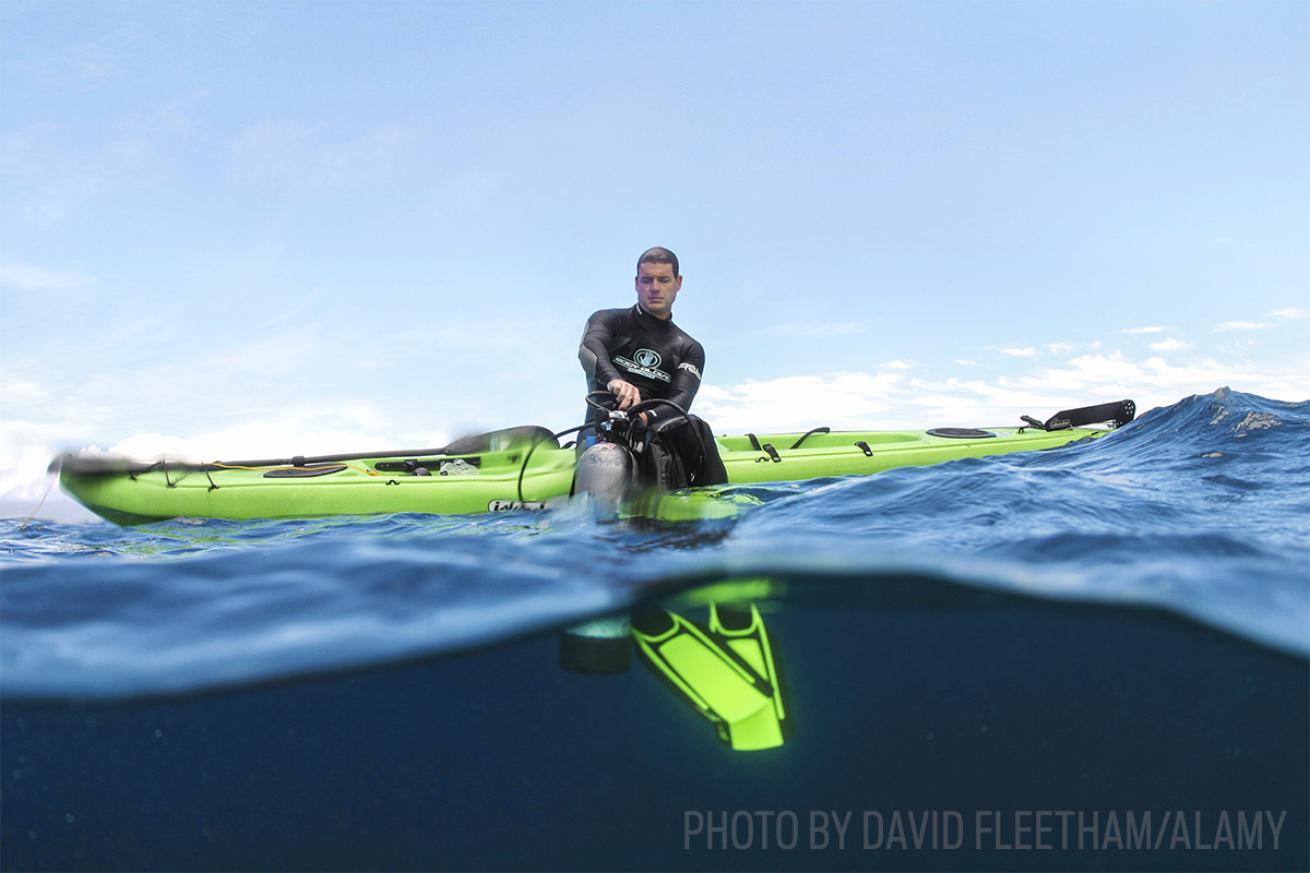
David Fleetham/Alamy Stock PhotoA diver regroups on his kayak off the coast of Maui, Hawaii
Add a kayak and triple the distance covered when compared with relying on just feet and fins to reach a dive site.
“Figure a triangle profile, paddle to the site, then dive for as much as two hours in one direction [if shallow], and paddle home,” says kayak diver Tom Eimer.
His tricks: The line connecting diver to kayak needs a surplus of 20 feet. Attach a dive weight at the end of the line. And divers who anticipate setting the line down at any point should wrap the first 20 feet in yellow tape to make spotting it easier.
31. Snorkel Alongside Sailfish
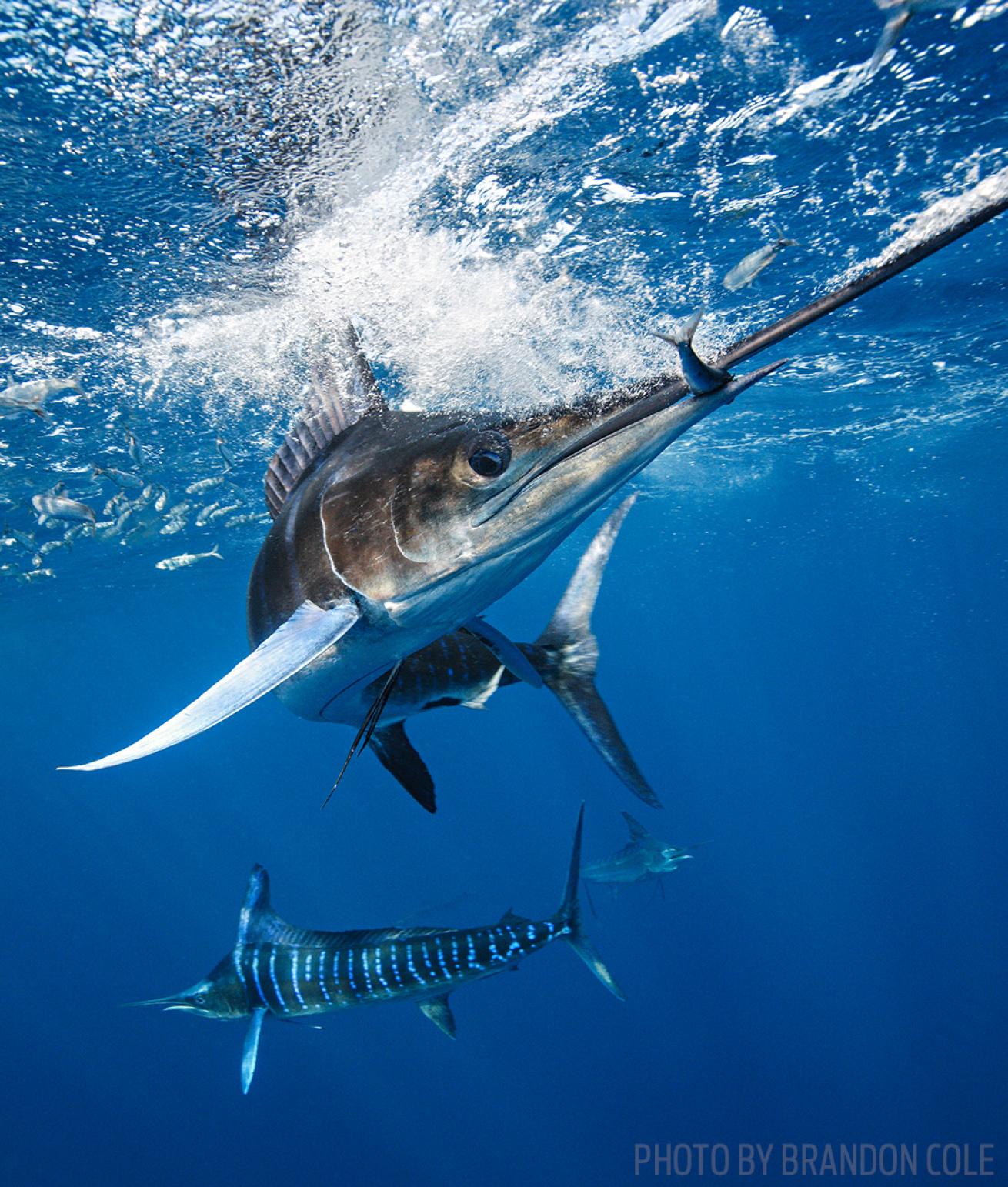
Brandon ColeSailfish feeding off the western coast of Mexico
It’s the sailfish’s bursts of 60 mph speed combined with its 3-foot-long needlelike nose that wakes up a diver’s limbic system. The most reliable spot for North Americans to mingle with these 6-foot predators is the open ocean between Mexico’s Isla Mujeres and Cancun. These gorgeous fish hunt cooperatively, sometimes in schools numbering upwards of 20. Divers looking to join this party should head to Mexico any time from December through March and be comfortable diving in blue water with no fixed reference point. prodiveinternational.com
32. Get the Inside Scoop
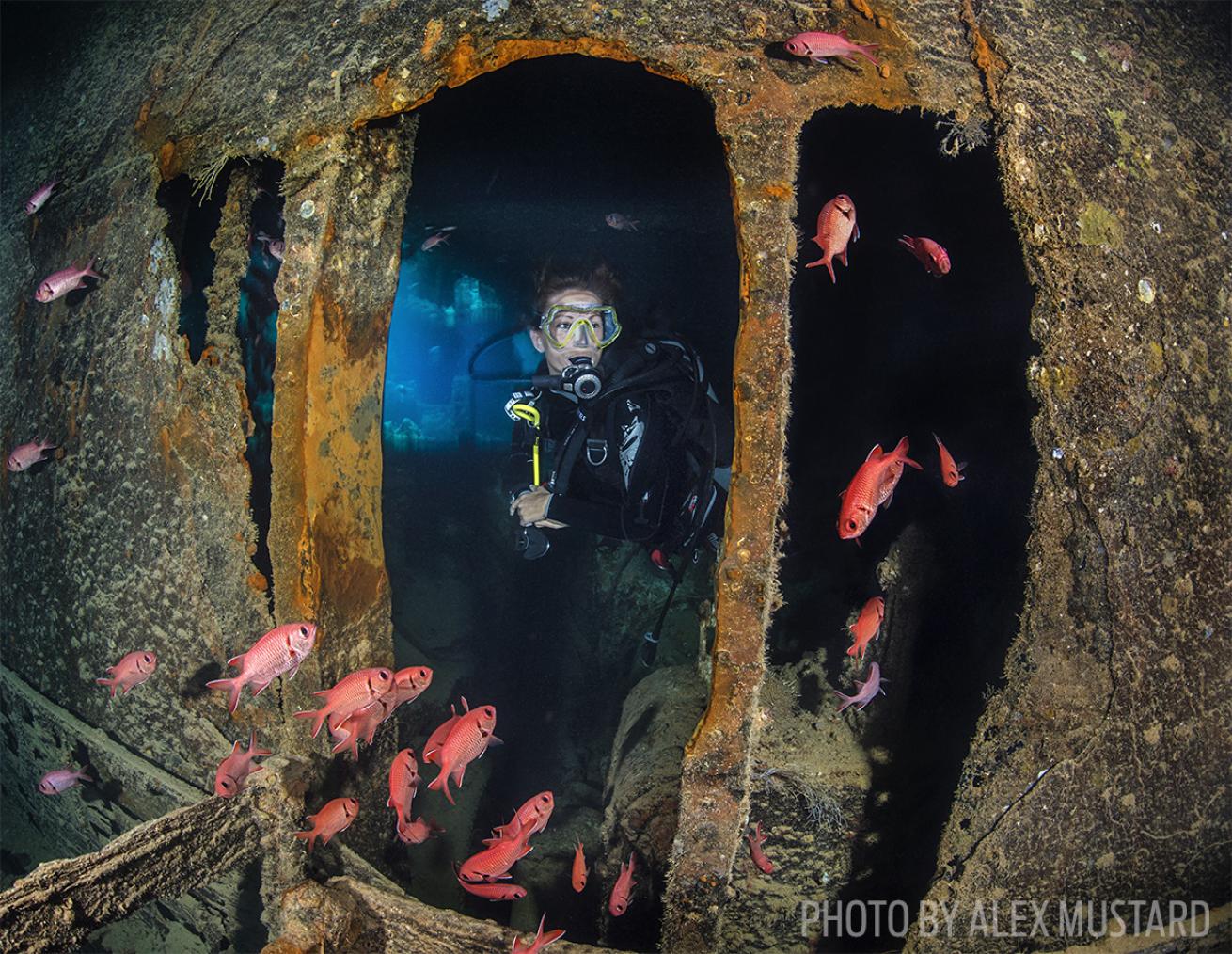
Alex MustardA diver fins through the Thistlegorm
The stories lie within. Wrecks are breathtaking to behold from the outside, but only when divers navigate the cargo holds, engine rooms, officers’ quarters and beyond can the full impact of the history resonate. Take the 415-foot SS Thistlegorm, found off the coast of Egypt. This British navy ship consistently ranks among the world’s top 10 wrecks because even Open Water divers can penetrate cargo holds containing Bedford trucks, motorcycles, crates of medical supplies and rifles in racks, pointing to the surface.
33. Explore on a Rebreather
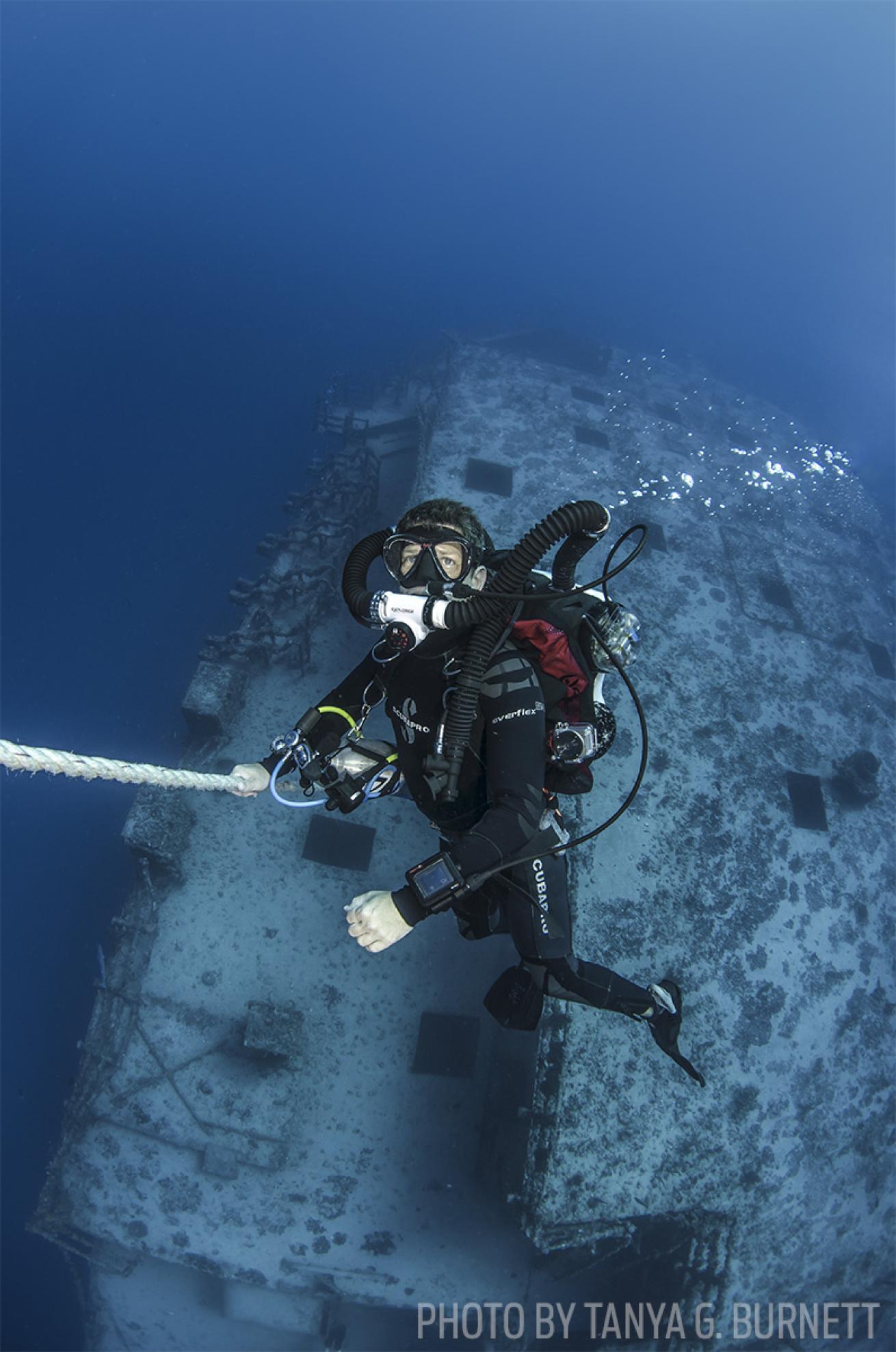
Tanya G. BurnettA diver ascends from the Spiegel Grove on a Hollis Explorer
You Know You Are Ready When ...
You are experienced and have basic knowledge of gas-exchange physics and great buoyancy skills. Not just anyone can jump into a rebreather course. PADI requires students to have Open Water and Enriched Air Diver certifications.
“The first thing I ask people is how much they dive in a year,” says Dan Dawson, tec dive instructor with Horizon Divers in Key Largo, Florida. Those who take two dive trips each year won’t be using the consumables before they go out of date.
But the training makes sense for the weekend warrior who takes every chance to dive that arises. And of the lot who dive often, the next consideration is: How comfortable are you with numbers?
“You have to be somewhat tech savvy and enjoy tinkering with gear and high-tech computers,” says Dawson. Much of the experience involves streamlining gear and monitoring a computer.
But for those who meet the criteria, rebreathers rewrite the dive experience.
“Sharks aren’t scared of you — they get closer,” says Dawson. “On rebreather, I was lying on the deck of the Duane when a turtle crawled up to the camera and began biting my dome. I had to buff out the scratches, but it was worth it.”
The ocean truly becomes the silent world when you’re diving on a rebreather.
“Only when you’re on rebreather do you realize how loud open-circuit diving is,” says Dawson. “A group of divers can sound like a pack of Darth Vaders.”
34. Don Vintage Gear

Olga TorreyDivers don vintage gear in Dutch Springs, Pennsylvania
Anyone curious about what it was like inside the Mark V surface-supplied-air helmet can find out in Key Largo, Florida. The half-day program, aptly called Dive a Mark V, will bring a buddy pair to try the suit. Divers must be 16 years or older, and comfortable donning 150 pounds of gear. It might not be an experience that delivers a transferable skill set, but, aside from happy-hour fodder, it should inspire a renewed appreciation for the freedom of today’s gear.
35. Venture into a Cenote
It’ll feel like you’re diving a haunted house with a dry-ice fog creeping around. Angelita Cenote is an experience that can be had by divers who trek to the Mexican town of Tulum. Then, from the cenote’s parking lot, it’s a five-minute walk through the jungle. Then the dive itself is a 200-foot descent. The layer that appears as smoke, found at 90 feet, is hydrogen sulfide. And it’s part of the mystical beauty that keeps divers coming back. cavetrainingmexico.com
36. Swim with the Snakes in a River

Brandon ColeA green anaconda in Brazil
Luck might be the biggest factor in determining safety when diving with the 20-foot female green anacondas of Brazil’s Amazon River.
“The anaconda doesn’t eat often — only a few times a year,” says photographer Franco Banfi, who’s made the long haul twice to the state of Mato Grosso, Brazil, for these encounters. The odds are low enough to make most divers feel safe. And besides, these behemoths are slow-moving. Sluggish. Like most snakes, they give a warning — unhinging their jaws to flash their incisors — when threatened.
Says Banfi, “They are not so easy to spot — you don’t find one every time.” But the hard work of the hunt pays off when you witness one of nature’s most respected beasts.
37. Take a Wild Ride
Start with a current and add an odd twist of topography, and out comes a looping, carnival-like underwater ride. Two are appropriately named Washing Machine. One such dive is in the Bahamas, off the west coast of Highbourne Cay. An incoming tide twirls divers toward the bottom, then spins them back up. Tobago is also home to a Washing Machine dive, where converging currents roll and twist divers around a patch of reef where mantas come to feed on plankton that get caught in the thrilling spin cycle.
38. Feed Sharks
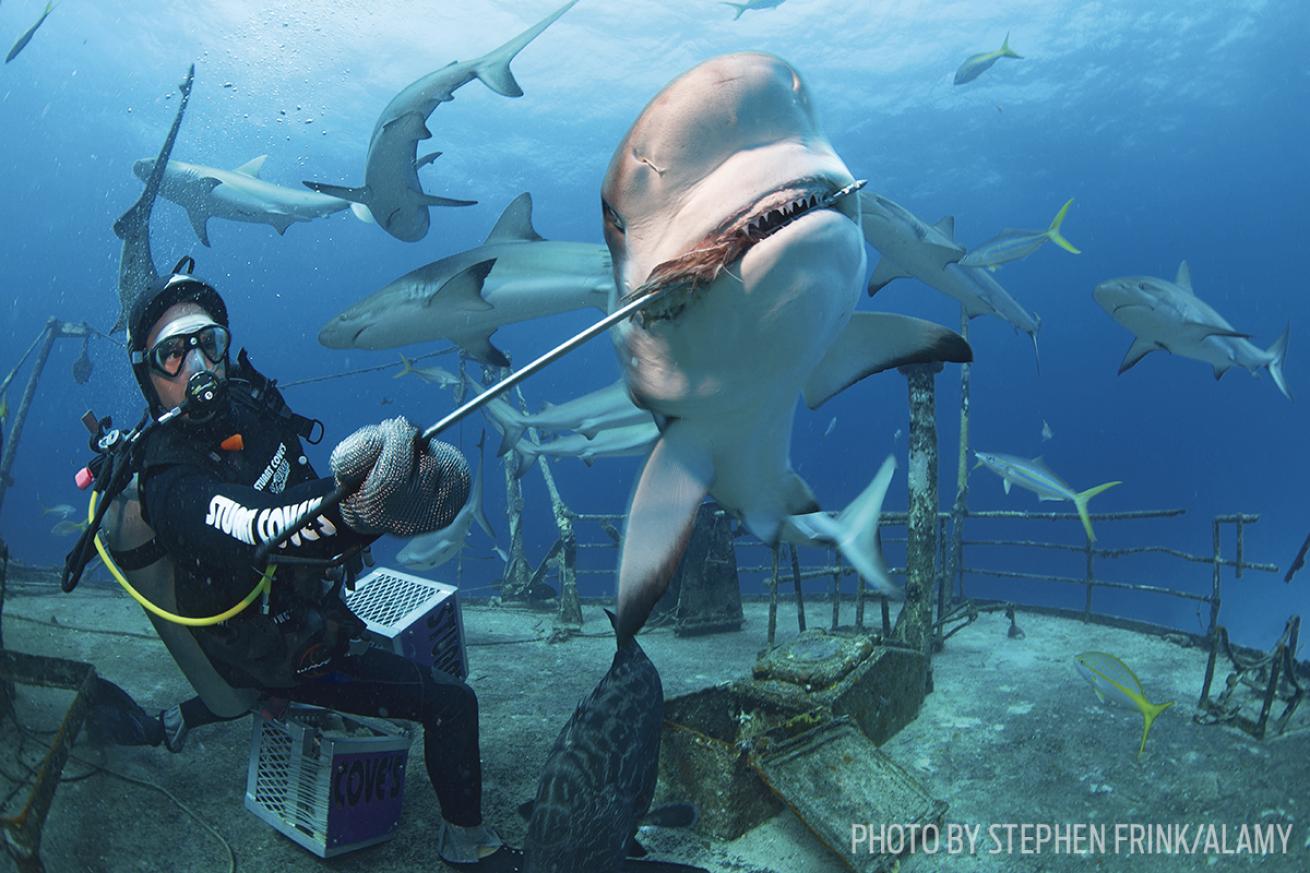
Lia BarrettA shark takes a bite of a snack off New Providence Island in the Bahamas
The experience is called polite feeding. That is, shark feeders control each piece of bait, selecting which shark they will offer it to. This is what divers can do through courses such as Stuart Cove’s shark-feeder program. Participants must be 18, but otherwise, even someone with an Open Water certification can partake, so long as they feel extremely comfortable in the water.
The three-day experience includes classroom time, plus apprentice-like training alongside a feeder, with both student and master wearing chain mail.
“Should the shark bite you on the arm, you’re protected by the chain mail, but this can still freak people out,” says Liz Parkinson, PADI Master Scuba Diver Trainer. As can meeting all the guests of the feed.
“Even being in the middle of 40 sharks swimming circles can be overwhelming,” she adds.
But the thrill is like no other. Says Parkinson, “After you’ve fed sharks, watching someone else do it is anticlimactic.” stuartcove.com
39. Dive with Orcas
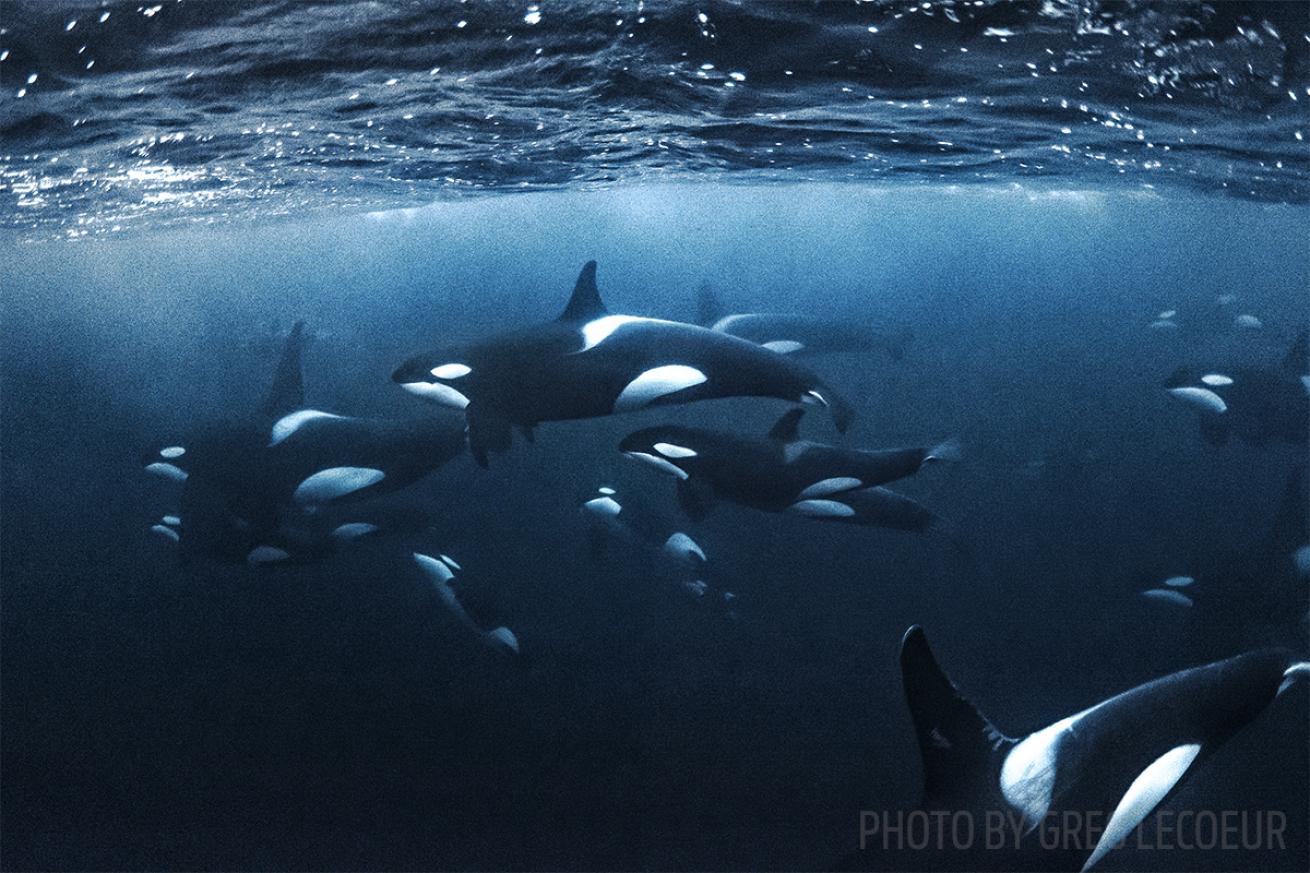
Greg LecoeurOrcas travel in a pod off Norway
“We spotted two fishing boats first,” says underwater shooter Greg Lecoeur of the gray morning he set out from Andenes, Norway, to find orcas. “When I see the fishing boats in the fjord, it feels like a jackpot because then I know the orcas are here,” says Lecoeur.
Sure enough, Lecoeur drops into the water to find approximately 200 orcas taking advantage of the fishermen’s nets, using them as walls to trap schools of herring. Again and again, they slap the water with their tails, stunning their trapped quarry.
“Then the orcas take their time choosing which fish to eat, picking the biggest one because the herring are moving so slowly, like they’re drunk,” says Lecoeur of the 45-minute big-animal experience.
Exiting the water proves difficult, not only because this show is such a rare treat, but also because air temperatures are 7 degrees F, much more brisk than the sea’s 43 degrees. The consolation was the panorama he surfaced to.
“This time of year, the low-light conditions make it like sunset all day. That, and snow is coming down in the afternoon light, set against a mountain backdrop — it’s all so amazing, you forget the cold completely.”
40. Shipwrecks of the Great Lakes
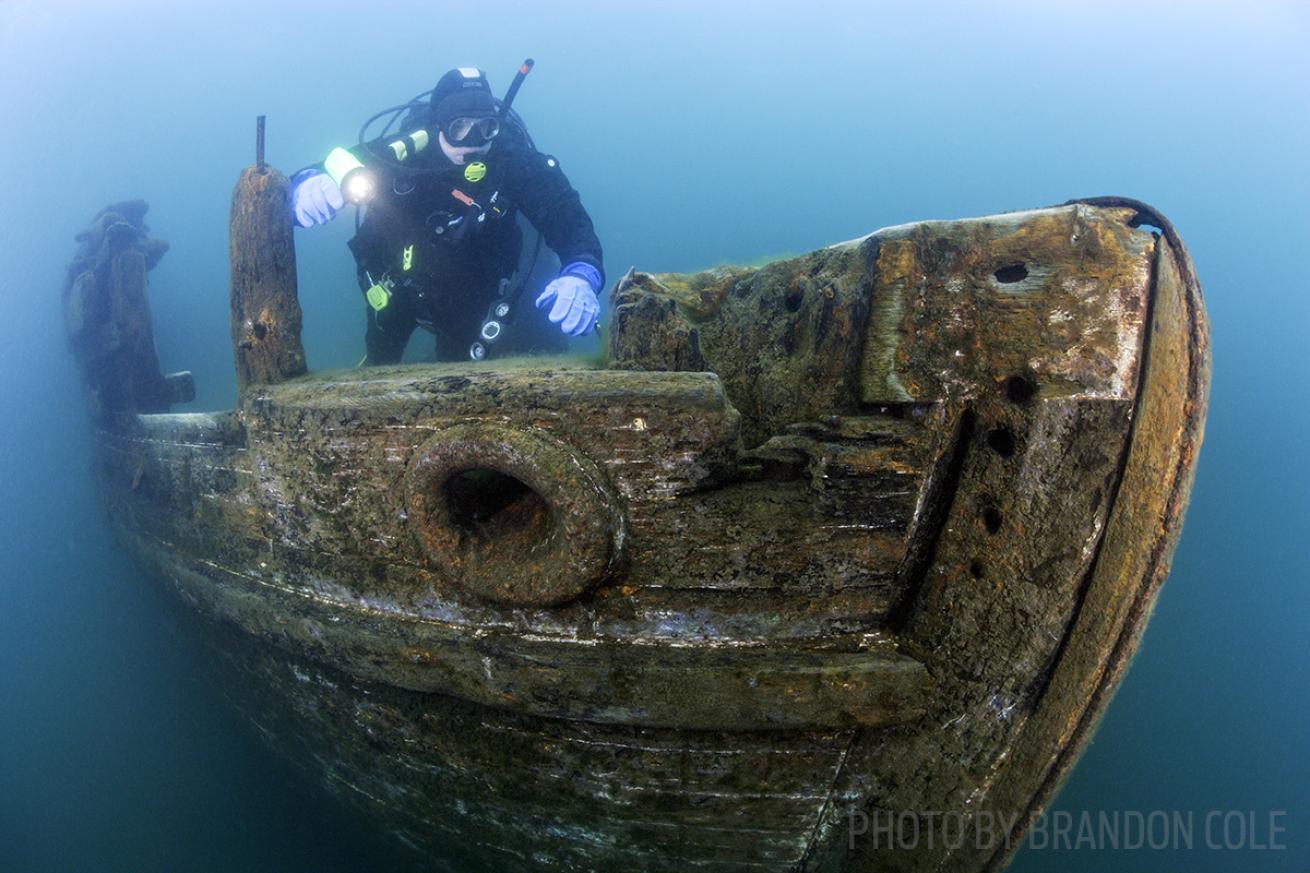
Brandon ColeA diver explored the Bermuda
• Estimated total wrecks: 25,000
• Includes wrecks that sank more than 100 years apart
The Great Lakes are notorious for cold water, which does wonders for preserving ships. Pick a wreck from each lake for the ultimate Great Lakes wreck trek and bragging rights among your dive buddies.
In Lake Superior, the two-masted Bermuda (above) is one of the most accessible wooden schooners for divers: It sits in just 15 feet of water off the coast of Munising, Michigan. Lake Michigan’s Prins Willem V, an intact 254-foot freighter, excites any diver looking to penetrate: One popular route starts next to a skylight in the engine room and ends at a crack near the bulkhead. The galley, wheelhouse and crew quarters can all be easily accessed, and the wreck lies in just 45 feet of water. Head to Lake Huron to dive the 112-foot wooden schooner E.B. Allen in the Thunder Bay National Marine Sanctuary, reachable from the town of Alpena, Michigan.
Lake Erie’s pride is the 90-foot Schooner G, a two-masted wooden schooner, well-preserved in 165 feet of water off Dunkirk, New York.
Further east, Lake Ontario claims the St. Peter, a three-masted 135-foot schooner at 117 feet, intact down to the bowsprit.
41. Dive into Photography

Tobias FriedrichA photographer enjoys the boat ride to a site off Norway
You Know You Are Ready When ...
You have learned marine behavior because, as an underwater photographer, you’ll need to approach a subject without spooking it. “You need to be able to get into and out of tight places without damaging the reef,” says Decker.
“The number-one mistake new photographers make is that they’re too far away,” says Jim Decker, CEO of Backscatter, a Monterey, California-based distributor of underwater photography gear. Backscatter is also known for on-location photo expeditions, including a wide-angle boot camp (this year, held January 2017 in Little Cayman).
Much like a workout boot camp that whips budding athletes into shape, the photo boot camp drills skills such as shooter position, composition framing and lighting into each participant. “I see a setup and then I signal, ‘Look,’ and I position myself, I position my strobes, and I take the shot,” says Decker. “I show them the back of my camera, and then I challenge them to take the same shot.”
Once a diver has these techniques, the entire dive experience changes.
“Diving becomes an emotional roller coaster in terms of getting shots,” says Decker.
Nonphotographers might travel in the hopes of seeing specific critters, but photographers often visualize a list of specific shots they’re hoping for, making it that much sweeter when they play out on a dive. backscatter.com
42. Hook and Hang
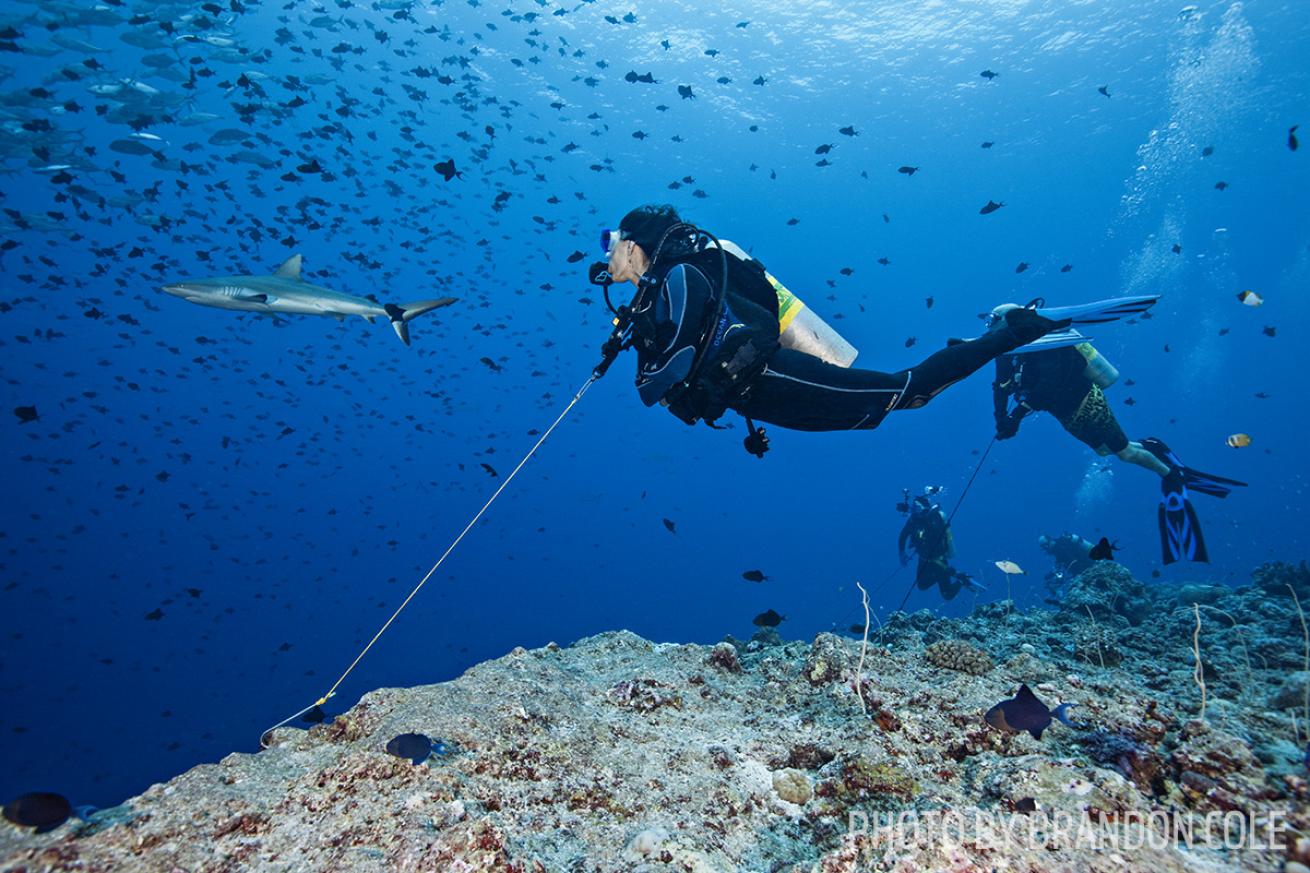
Brandon ColeDivers at the Blue Corner dive site in Palau
Palau, Indonesia and the Philippines are among the destinations where hook-and-hang diving has become de rigueur. And rightly so. Fighting the currents that usher in legions of sharks would only detract from the main attractions. At Palau’s Blue Corner (pictured above), air supplies stay high as humphead wrasse, whitetip and blacktip reef sharks, and schools of barracuda all pass by and you take in the sights while secured to a rocky edge, waiting for what the current will bring in next. samstours.com
43. Try Bareboat Diving

Steve SimonsenThe McGregor II yacht in the British Virgin Islands
There’s nothing sweeter than having your morning coffee and immediately giant-striding to begin a dive on your own time — sometimes just after sunrise to beat any crowds. It’s sort of like liveaboard diving but with a custom itinerary. At dive locales such as the British Virgin Islands, bareboat diving adds a challenge in that you’re reading nautical charts or GPS devices to anchor or moor a vessel close to a target. It helps that the water’s so clear that on a sunny day, a boater can simply eyeball the bottom to find a choice position.
44. Get a New Career
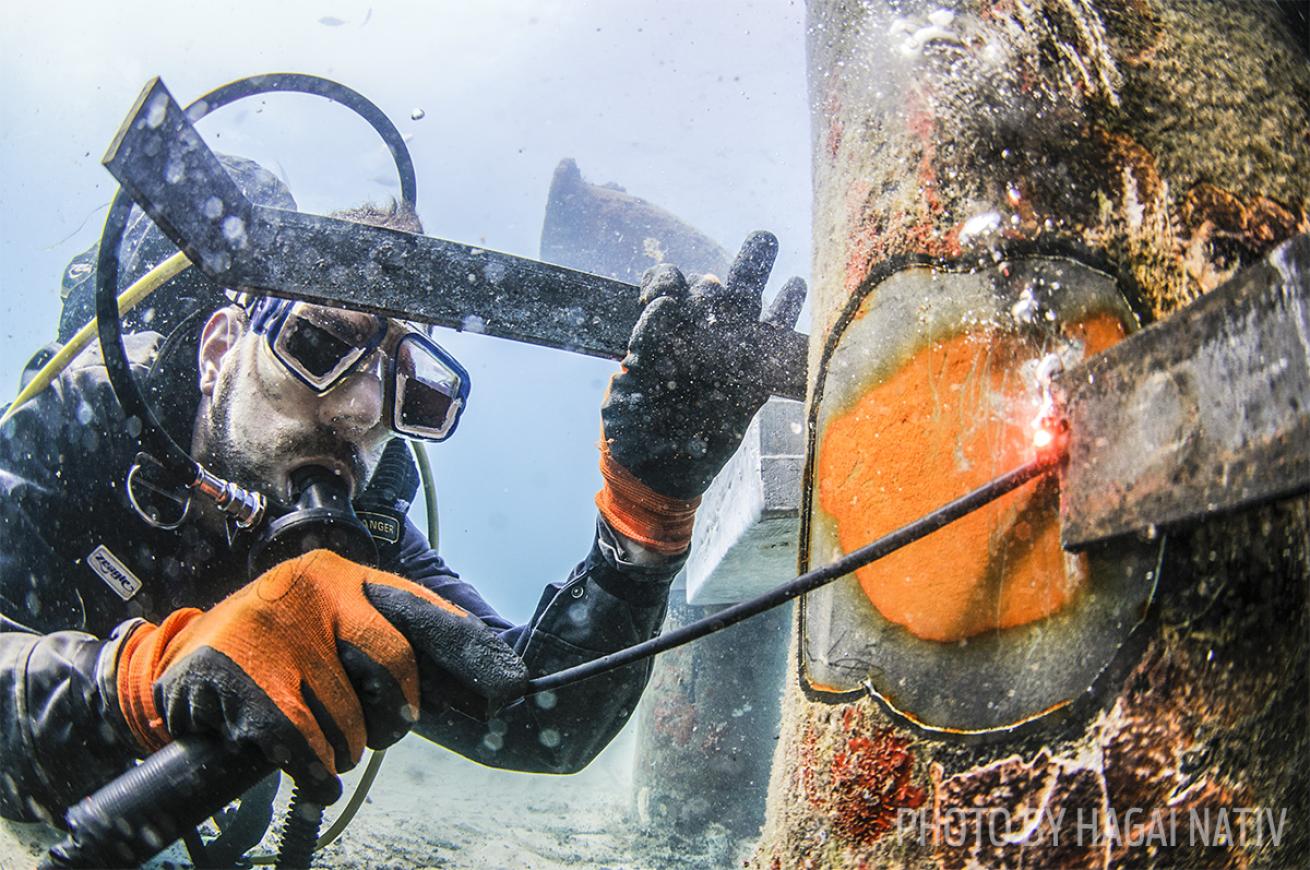
Hagai Nativ/PhotoStock-Israel.comA commercial diver works on underwater piping
“People think commercial diving means underwater welding, but only 1 percent of what a commercial diver does is weld,” says Brian Staley, director of the Ocean Corporation, which trains those looking to enter this profitable sector of the industry. That other 99 percent entails demolition — “Yes, it’s as exciting as it sounds,” says Staley — as well as construction, repairs, salvage and inspection of sites ranging from water towers, dams and nuclear power plants, where, yes, the hazard pay is substantial. oceancorp.com
45. Probe British Columbia Walls
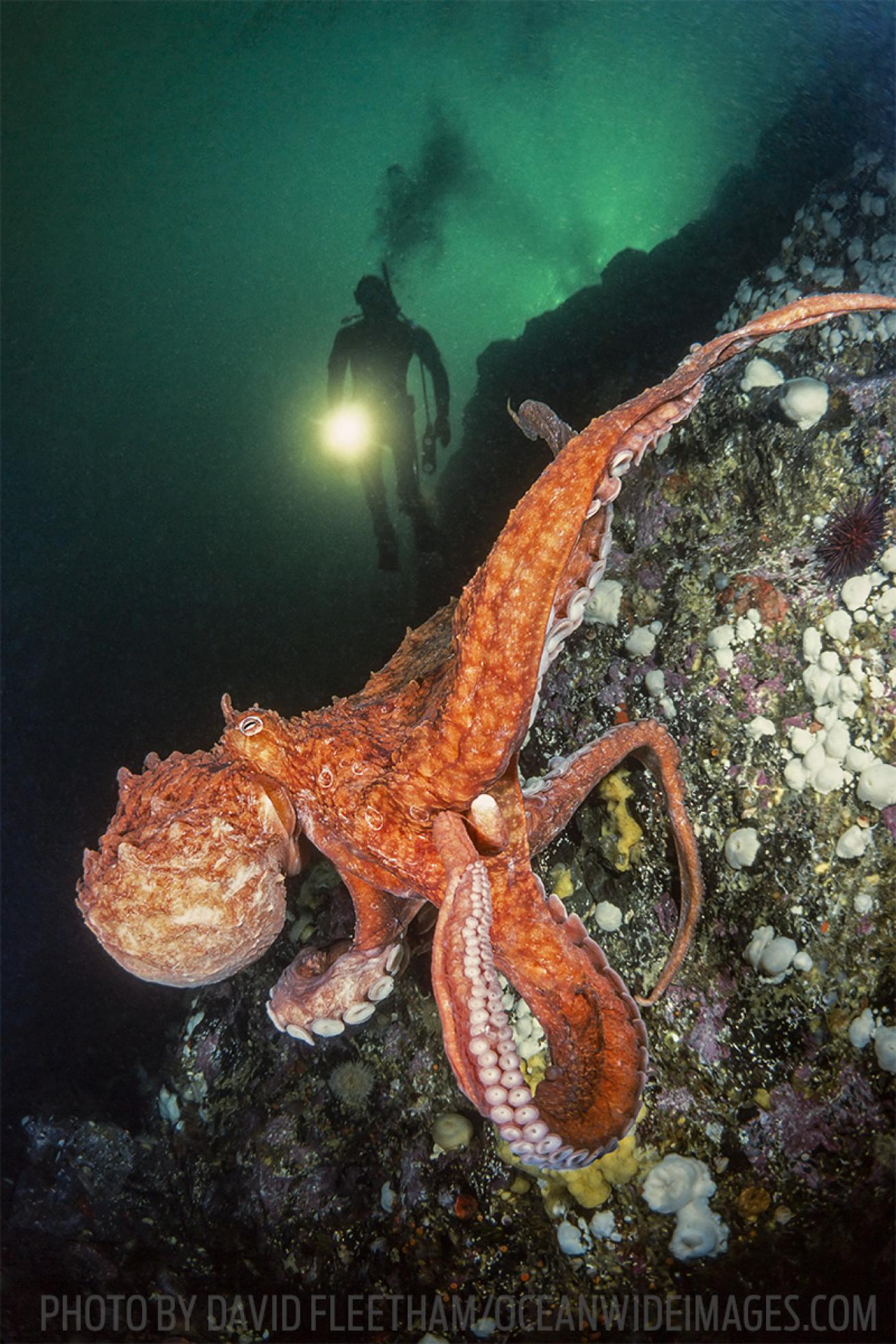
David Fleetham/OceanwideImages.comA giant Pacific octopus off British Columbia
“The currents really rip through Discovery Passage,” says underwater photographer David Fleetham.
That passage feeds into the Campbell River area, located roughly in the middle of the northern coast of Vancouver Island. Because the currents are mask-rippingly strong, divers must coordinate bottom time with slack tides — which could mean having just 37 minutes on the wall.
Use it wisely. To score face time with a giant Pacific octopus (above), look for the pile of crab carapaces outside, marking a midden. “You find them with heads the size of your hand, and even as big as 12 feet across with heads the size of two basketballs,” says Fleetham. “It’s the smaller ones, though, that can get a better grip.”
Which one did, yanking his strobe out of position just before the tide began moving again — the signal to pack up and head for the surface. Although tides demand a greater awareness around these parts, they’re worth contending with.
“Most people avoid current,” says Fleetham, “but that’s what I target the most, because moving water means moving food.” And the savvy diver knows that with a bigger buffet of food comes bigger marine life queuing up for a meal.
46. Earn a Nitrox Certification

Gerald NowakA diver uses nitrox to explore
“This is such an easy class, which you can even take online in three hours,” says Dan Dawson, instructor for Horizon Divers in Key Largo, Florida.
Sometimes divers procrastinate when it comes to a nitrox cert, and if you’re planning on diving the rest of your career at 60 feet or shallower, Dawson says that’s a smart move. But otherwise, if you’re a regular diver of Florida’s east coast or any other location where most sites lie at depths of 70 feet and greater, stop procrastinating. And for buddy pairs where one is nitrox certified, the other may need a push.
It helps that the course is fairly straightforward. One of the biggest considerations is bearing in mind that maximum operating depth, or MOD, will change. On air, a recreational diver has free rein to 130 feet. Dive 32 percent nitrox— that is, a tank of enriched air nitrox with 32 percent oxygen — and a diver can’t toe past 111 feet. The overall gain is that nitrox buys you more time at depth and, says Dawson, “makes off-gassing a lot better — clearer.”
Learning to analyze a tank — measuring the oxygen content to ensure it is as advertised — is a bit of a bother. So is filling a car’s gas tank, but that’s second nature to anyone who has blown out 16 birthday candles. And the certification is a gift that keeps on giving.
47. Try a Shore Dive
Don’t forget booties and open-heel fins when shore diving — or carry flip-flops in your BC pocket, because navigation mistakes are inevitable but easily fixed with a walk. Night shore diving is even more of a teacher. Until it happens, you don’t realize that the light you’d been swimming toward isn’t marking what you thought. Walk enough, and you’ll hasten mastering not just a compass, but skills such as triangulation. Most often, mistakes mean little more than burning off enough calories to warrant seconds come dinnertime.
48. Dive at Altitude
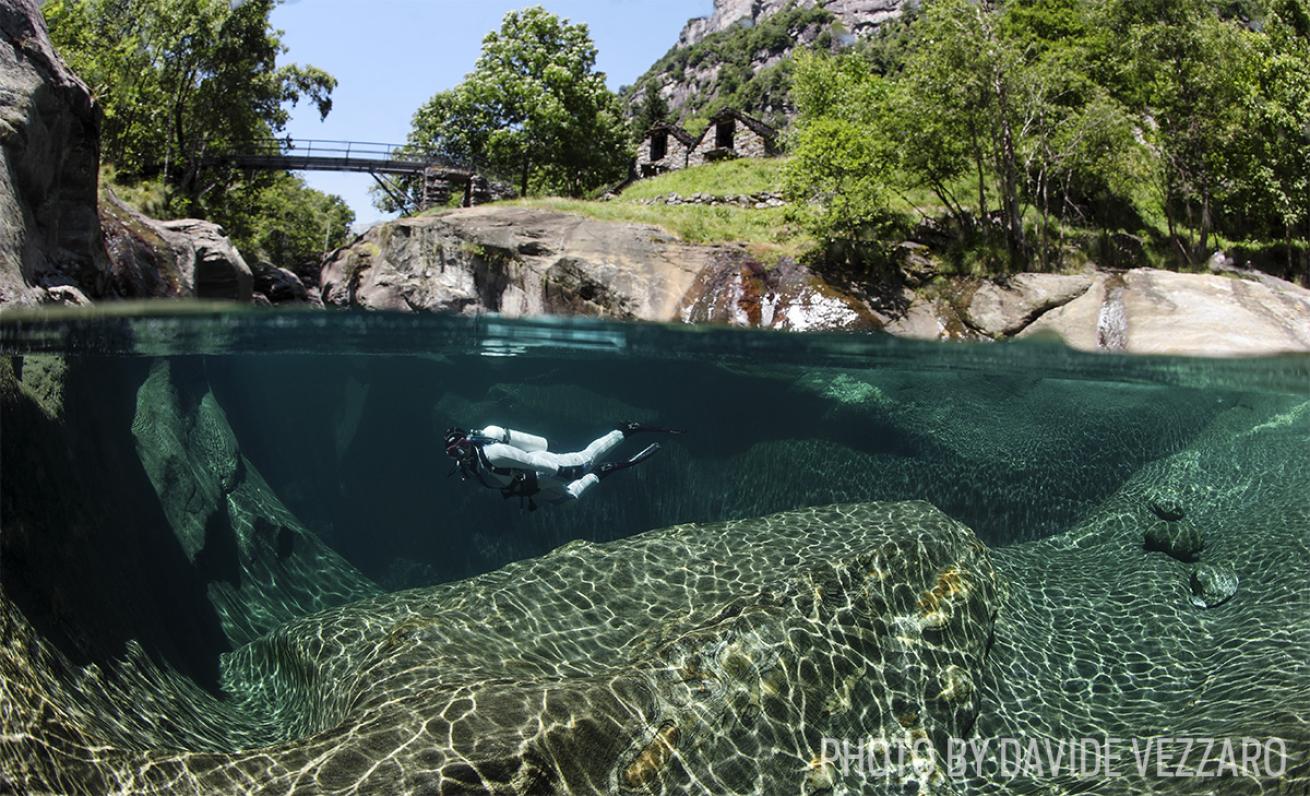
Davide VezzaroDivers in Switzerland's Verzasca river
The numbers that make altitude dives challenging aren’t the ones you’d think. Dive computers automatically factor elevation, so divers needn’t do much more than be aware of limited bottom time. The bigger issue is temperature. Mountain-fed rivers or lakes come spring can be significantly colder, further shortening dive times. Why go? Places such as Switzerland’s Verzasca River not only have gorgeous water-carved granite formations, but that frigid, clear water also grants epic views.
49. Perfect Your Trim
Anyone who hits the holiday buffet hard isn’t immune to the occasional adjustment of weight. Before you see a buddy’s photo showing that your feet float higher than your noggin, reshuffle those weights. After all, don’t we all want to be as streamlined as the marine life we’re suiting up to see?
50. Go Black-Water Diving

Masa Ushioda/Seapics.comLuminescent marine creatures shine at night off the Kona coast.
This type of dive stirs the anxiety of even the most seasoned vets — it feels like dive No. 1 all over again.
The challenge is purely mental to accept that one’s fins dangle over a bottom never seen. “After you jump in, this is the easiest dive we have,” says Jeff Leicher of Jack’s Diving Locker on Hawaii’s Big Island.
Divers are tethered behind the boat, where they watch as oddities from the deep rise to feed. A comb jelly, the Venus girdle (pictured) is one of the creatures most likely seen. It relies on its mucuslike body to catch copepods, a zooplankton, then curls up to transfer dinner to its mouth. Says Leicher, “They’re beautiful, but oh so bizarre.” jacksdivinglocker.com; konahonudivers.com; bigislanddivers.com



